10 of the most impressive superyachts owned by billionaires
From a sailing yacht owned by a russian billionaire industrialist to the luxury launch of the patek philippe ceo, here are the best billionaire-owned boats on the water….
Words: Jonathan Wells
There’s something about billionaires and big boats . Whether they’re superyachts or megayachts, men with money love to splash out on these sizeable sea-going giants. And that all began in 1954 — with the big dreams of Greek shipping magnate Aristotle Onassis.
Onassis, keen to keep his luxury lifestyle afloat when at sea, bought Canadian anti-submarine frigate HMCS Stormont after World War II. He spent millions turning it into an opulent super yacht, named it after his daughter — and the Christina O kicked off a trend among tycoons. To this day, the world’s richest men remain locked in an arms race to build the biggest, fastest, most impressive superyacht of all. Here are 10 of our favourites…

Eclipse, owned by Roman Abramovich

Built by: Blohm+Voss of Hamburg, with interiors and exteriors designed by Terence Disdale. Launched in 2009, it cost $500 million (the equivalent of £623 million today).
Owned by: Russian businessman Roman Abramovich, the owner of private investment company Millhouse LLC and owner of Chelsea Football Club. His current net worth is $17.4 billion.
Key features: 162.5 metres in length / 9 decks / Top speed of 22 knots / Two swimming pools / Disco hall / Mini submarine / 2 helicopter pads / 24 guest cabins
Sailing Yacht A, owned by Andrey Melnichenko
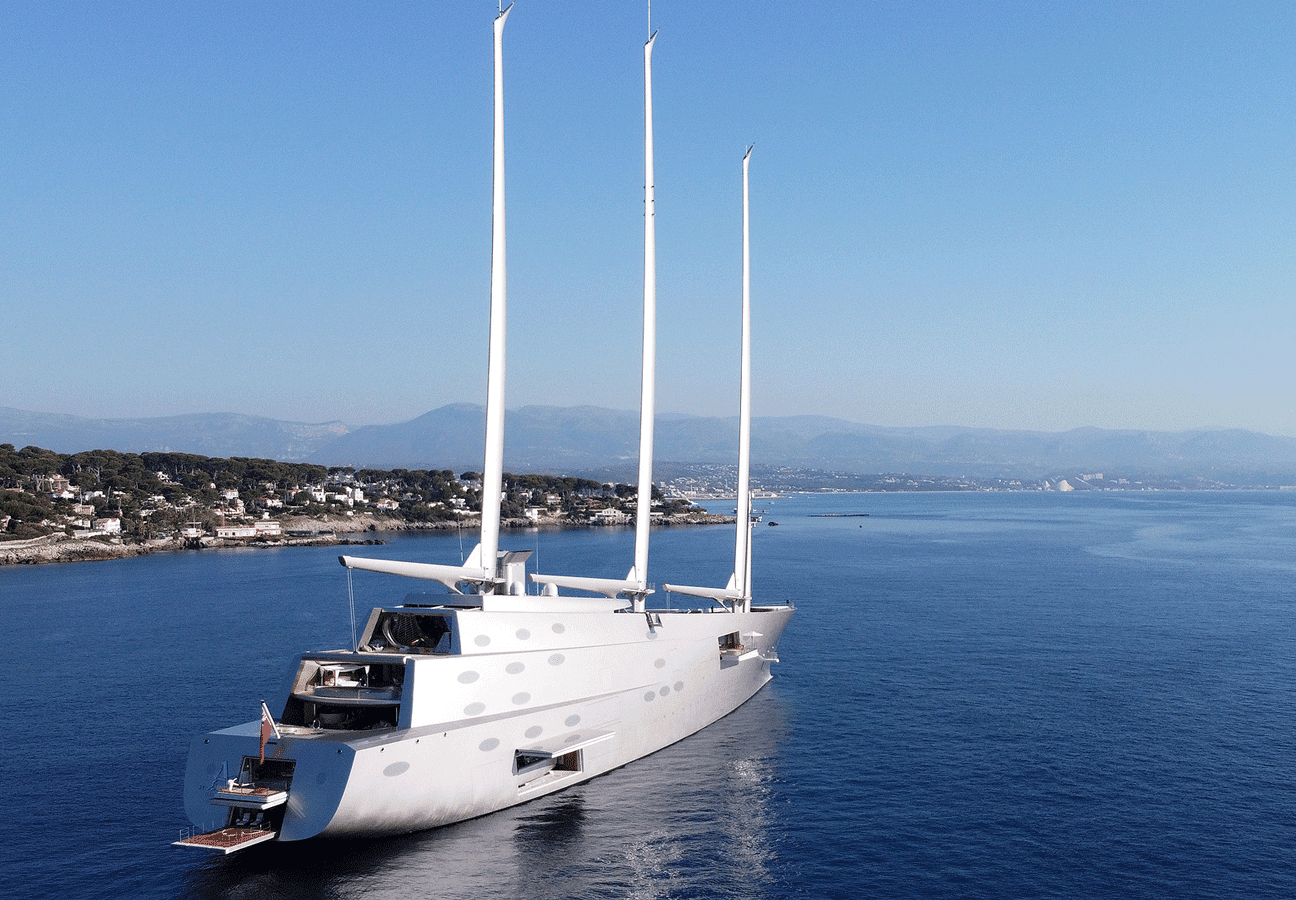
Built by: Nobiskrug, a shipyard on the Eider River in Germany. The original idea came from Jacques Garcia, with interiors designed by Philippe Starck and a reported price tag of over $400 million.
Owned by: Russian billionaire industrialist Andrey Melnichenko, the main beneficiary of both the fertiliser producing EuroChem Group and the coal energy company SUEK. Though his current net worth is $18.7 billion, Sailing Yacht A was seized in Trieste on 12 March 2022 due to the EU’s sanctions on Russian businessmen.
Key features: 119 metres in length / 8 decks / Top speed of 21 knots / Freestanding carbon-fibre rotating masts / Underwater observation pod / 14 guests
Symphony, owned by Bernard Arnault

Built by: Feadship, the fabled shipyard headquartered in Haarlem in The Netherlands. With an exterior designed by Tim Heywood, it reportedly cost around $150 million to construct.
Owned by: French billionaire businessman and art collector Bernard Arnault. Chairman and chief executive of LVMH, the world’s largest luxury goods company, his current net worth is $145.8 billion.
Key features: 101.5 metres in length / 6 decks / Top speed of 22 knots / 6-metre glass-bottom swimming pool / Outdoor cinema / Sundeck Jacuzzi / 8 guest cabins
Faith, owned by Michael Latifi

Built by: Similarly to Symphony above, also Feadship. With exteriors designed by Beaulieu-based RWD, and interiors by Chahan Design, it cost a reported $200 million to construct in 2017.
Owned by: Until recently, Canadian billionaire and part-owner of the Aston Martin Formula 1 Team , Lawrence Stroll. Recently sold to Michael Latifi, father of F1 star Nicholas , a fellow Canadian businessman with a net worth of just under $2 billion.
Key features: 97 metres in length / 9 guest cabins / Glass-bottom swimming pool — with bar / Bell 429 helicopter
Amevi, owned by Lakshmi Mittal

Built by: The Oceanco shipyard, also in The Netherlands. With exterior design by Nuvolari & Lenard and interior design by Alberto Pinto, it launched in 2007 (and cost around $125 million to construct).
Owned by: Indian steel magnate Lakshmi Mittal, chairman and CEO of Arcelor Mittal, the world’s largest steelmaking company. He owns 20% of Queen Park Rangers, and has a net worth of $18 billion.
Key features: 80 metres in length / 6 decks / Top speed of 18.5 knots / On-deck Jacuzzi / Helipad / Swimming Pool / Tender Garage / 8 guest cabins
Odessa II, owned by Len Blavatnik
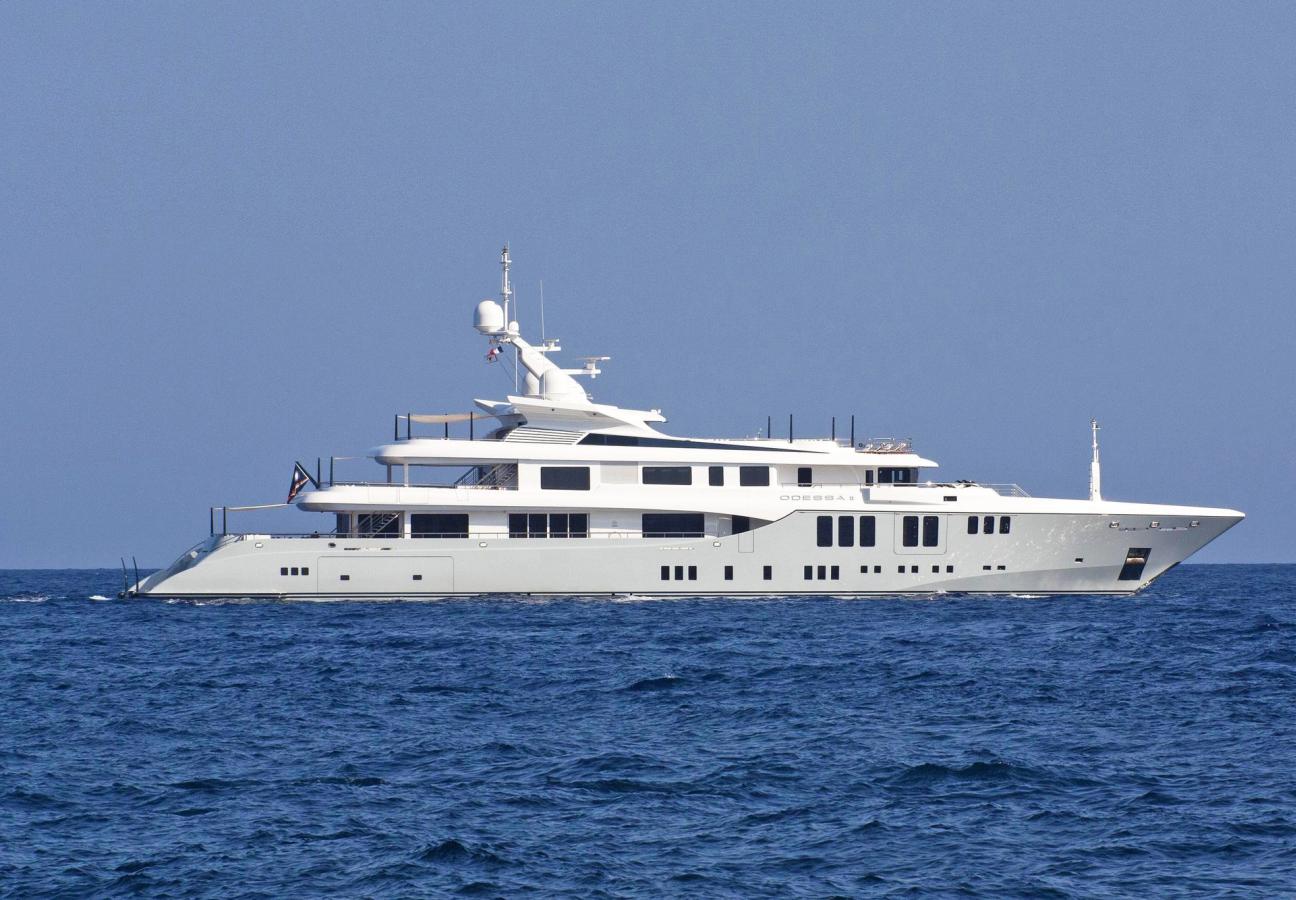
Built by: Nobiskrug, the same German shipyard that built Sailing Yacht A . Both interior and exterior were created by Focus Yacht Design, and the yacht was launched in 2013 with a cost of $80 million.
Owned by: British businessman Sir Leonard Blavatnik. Founder of Access Industries — a multinational industrial group with current holdings in Warner Music Group, Spotify and the Grand-Hôtel du Cap-Ferrat — he is worth $39.9 billion.
Key features: 74 metres in length / 6 guest cabins / Top speed of 18 knots / Intimate beach club / Baby grand piano / Private master cabhin terrace / Outdoor cinema
Nautilus, owned by Thierry Stern

Built by: Italian shipyard Perini Navi in 2014. With interiors by Rémi Tessier and exterior design by Philippe Briand, Nautilus was estimated to cost around $90 million to construct.
Owned by: Patek Philippe CEO Thierry Stern. Alongside his Gulstream G650 private jet, Nautilus — named for the famous sports watch — is his most costly mode of transport. His current net worth is $3 billion.
Key features: 73 metres in length / 7 guest cabins / Top speed of 16.5 knots / Dedicated wellness deck / 3.5 metre resistance pool / Underfloor heating / Jet Skis
Silver Angel, owned by Richard Caring

Built by: Luxury Italian boatbuilder Benetti. Launched in 2009, the yacht’s interior has been designed by Argent Design and her exterior styling is by Stefano Natucci.
Owned by: Richard Caring, British businessman and multi-millionaire (his wealth peaked at £1.05 billion, so he still makes the cut). Chairman of Caprice Holdings, he owns The Ivy restaurants.
Key features: 64.5 metres in length / Cruising speed of 15 knots / 7 guest cabins / Lalique decor / 5 decks / Oval Jacuzzi pool / Sun deck bar / Aft deck dining table
Lady Beatrice, owned by Frederick Barclay
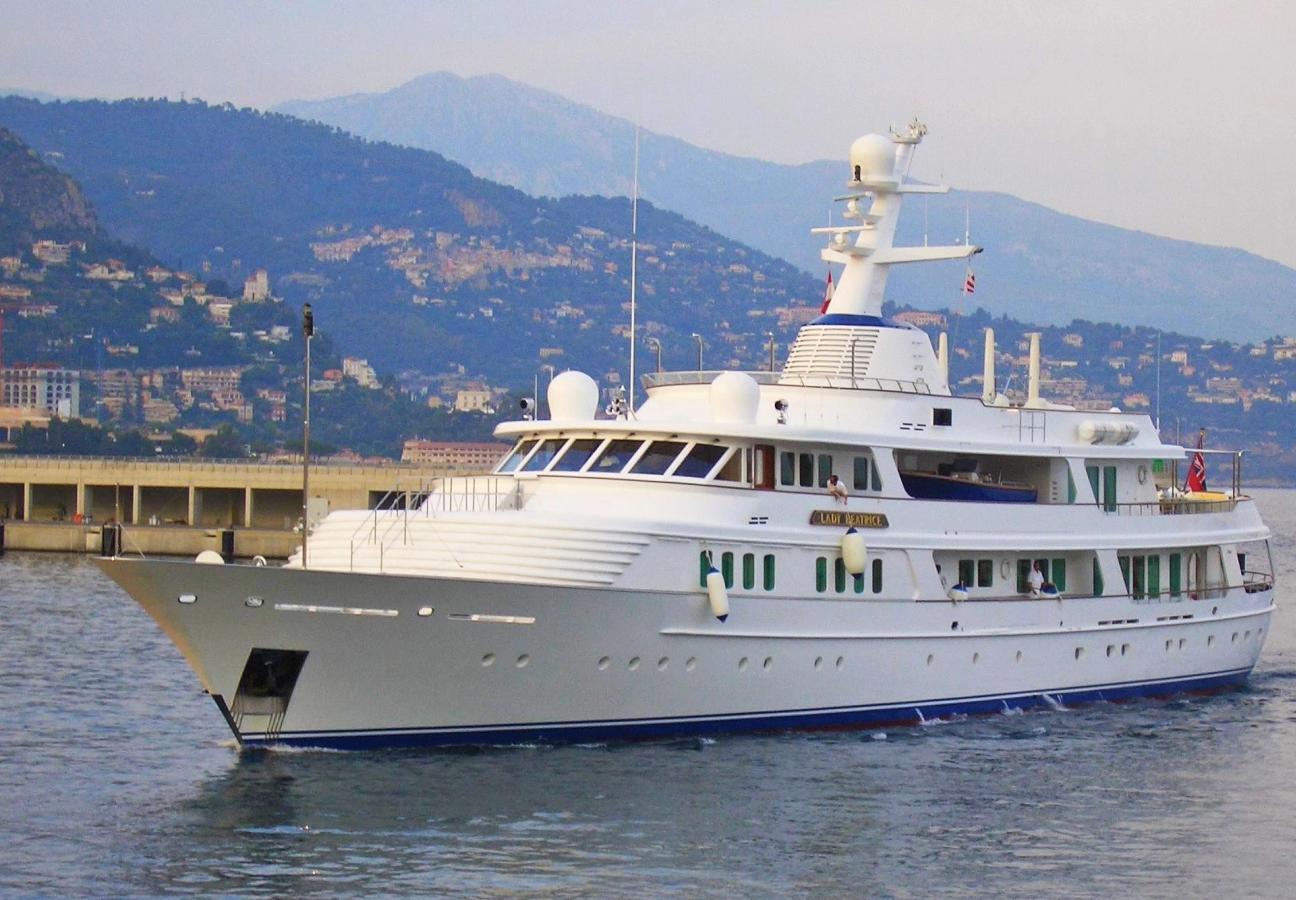
Built by: Feadship and Royal Van Lent in 1993. Exteriors were created by De Voogt Naval Architects, with interiors by Bannenberg Designs. She cost the equivalent of £63 million to build.
Owned by: Sir David Barclay and his late brother Sir Frederick. The ‘Barclay Brothers’ had joint business pursuits including The Spectator , The Telegraph and delivery company Yodel. Current net worth: £7 billion.
Key features: 60 metres in length / 18 knots maximum speed / Monaco home port / Named for the brothers’ mother, Beatrice Cecelia Taylor / 8 guest cabins
Space, owned by Laurence Graff

Built by: Space was the first in Feadship’s F45 Vantage series , styled by Sinot Exclusive Yacht Design and launched in 2007. She cost a reported $25 million to construct.
Owned by: Laurence Graff, English jeweller and billionaire businessman. As the founder of Graff Diamonds, he has a global business presence and a current net worth of $6.26 billion.
Key features: 45 metres in length / Top speed of 16 knots / Al fresco dining area / Sun deck Jacuzzi / Breakfast bar / Swimming platform / Steam room
Want more yachts? Here’s the handcradfted, homegrown history of Princess…
Become a Gentleman’s Journal member. Find out more here.

Become a Gentleman’s Journal Member?
Like the Gentleman’s Journal? Why not join the Clubhouse, a special kind of private club where members receive offers and experiences from hand-picked, premium brands. You will also receive invites to exclusive events, the quarterly print magazine delivered directly to your door and your own membership card.
Further reading

The best webcams to up level up your Zoom meetings
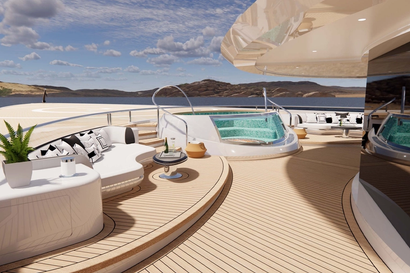
All you need to know about Kismet, the new £2.5m a week gigayacht
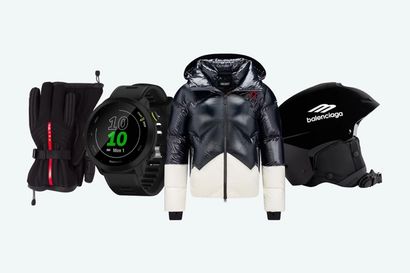
The best slope-worthy ski gear on the planet

The global authority in superyachting
- NEWSLETTERS
- Yachts Home
- The Superyacht Directory
- Yacht Reports
- Brokerage News
- The largest yachts in the world
- The Register
- Yacht Advice
- Yacht Design
- 12m to 24m yachts
- Monaco Yacht Show
- Builder Directory
- Designer Directory
- Interior Design Directory
- Naval Architect Directory
- Yachts for sale home
- Motor yachts
- Sailing yachts
- Explorer yachts
- Classic yachts
- Sale Broker Directory
- Charter Home
- Yachts for Charter
- Charter Destinations
- Charter Broker Directory
- Destinations Home
- Mediterranean
- South Pacific
- Rest of the World
- Boat Life Home
- Owners' Experiences
- Interiors Suppliers
- Owners' Club
- Captains' Club
- BOAT Showcase
- Boat Presents
- Events Home
- World Superyacht Awards
- Superyacht Design Festival
- Design and Innovation Awards
- Young Designer of the Year Award
- Artistry and Craft Awards
- Explorer Yachts Summit
- Ocean Talks
- The Ocean Awards
- BOAT Connect
- Between the bays
- Golf Invitational
- Boat Pro Home
- Pricing Plan
- Superyacht Insight
- Product Features
- Premium Content
- Testimonials
- Global Order Book
- Tenders & Equipment
The superyachts owned by tech moguls
Amazon founder Jeff Bezos is set to join the exclusive club of yacht-owning tech tycoons as the rumoured owner of Oceanco's mighty 127m sailing yacht . Though it should come as no surprise - other big names in tech such as the late Steve Jobs, Larry Ellison and Paul Allen have been responsible for some of the biggest and most ground-breaking superyachts in the world...
The 127-metre Oceanco sailing yacht Koru, formerly Y721, was launched and reportedly delivered to Amazon founder Jeff Bezos in April 2023. This three-masted schooner, meaning “new beginnings” in Maori, with an expected 33000 GT and a steel hull and aluminium superstructure, is the largest in the world and the longest built in the Netherlands at Oceanco. Knocking Lürssen's Eos , owned by Biller and Diane von Furstenburg, off the top spot, Koru harnesses design similarities with her black hull, white superstructure and classic lines. However, the intricate gold paintwork, scarlet bootstrap and elaborate figurehead on the bow particularly set her apart.
Larry Ellison
American business magnate Larry Ellison is the co-founder of the billion-dollar computer tech corporation Oracle. In 2004, he commissioned the 138-metre Lürssen superyacht Rising Sun (pictured), which stands today as the 15th largest yacht in the world. It was also the last yacht that ever came from the drawing boards of legendary designed Jon Bannenberg, sporting a military-esque profile with a lean destroyer-type hull and extensive use of structural glass . Rising Sun boasts 8,000m² of living space including a wine cellar and basketball court, with a crew of 45. One of her tenders, a catamaran, even carries the yacht’s 4x4 vehicle ashore.
Ellison later sold the yacht to media mogul David Geffen and has since hosted a parade of Hollywood's glitterati on board including Leonardo DiCaprio, Steven Spielberg, Bruce Springsteen and Oprah Winfrey – to name a few.
In 2011, Ellison appeared to downsize and took delivery of the 88-metre Feadship Musashi . Not unlike Rising Sun in its appearance, structural glass features heavily throughout with a central glass lift, surrounded by a stainless steel and glass staircase that passes through every deck.
More about this yacht
The late Microsoft co-founder Paul Allen is responsible for two of the most iconic superyachts in the world. At 126-metres in length, Octopus is perhaps his most famous. Built by Lürssen in 2003, this ice-classed superyacht was designed for extended cruising to the most remote locations on earth with a range of 12,500 nautical miles. Home to a helicopter garage, drive-in tender garage, six tenders, and a submarine, she packs a serious punch within her 9,932GT – not to mention the cinema, swimming pool, recording studio, basketball court and spa. At the end of 2019, she joined the market for the very first time , having completed an eight-month refit at Blohm+Voss, and remains the benchmark for exploration yachting.
Tatoosh is another honourable mention and was built by German shipyard Nobiskrug in 2000, three years prior to the delivery of Octopus . At 92-metres, she's smaller than her successor, but to describe Tatoosh as "small" would be a severe understatement. Highlights include a six-foot-deep swimming pool, a pair of helipads, a crew of 30, and a custom 12-metre Hinckley powerboat that she carries on her top deck. Tatoosh is also listed for sale following a refit earlier this year.
Yachts for charter
The 78-metre Feadship Venus was built for the late Apple boss and founder Steve Jobs. Built under the codename Project Aqua, Venus was launched to international fanfare in 2012, heralded for its extensive use of glass and pared-back design courtesy of Philippe Starck . Innovative features include a false top deck that conceals the communication and television receivers from view and a passarelle that, when opened, looks like the charging port of an iPhone. Venus ’s interior details have been closely guarded since its launch. Sadly, Jobs died a year before the yacht was delivered.
Charles Simonyi
Charles Simonyi led the team that built the first edition of the Microsoft Office software suite and was rumoured to have previously owned Lürssen’s iconic 71-metre SKAT . Nearly two decades after her launch in 2002, she joined the market for the first time and now Simonyi is thought to have upgraded to the 89-metre Lürssen Norn . Both yachts, penned by Espen Onion, share similar design features. Standout features include an alfresco cinema and adapted depth pool floor with dance floor. Norn was delivered in May 2023.
Sergey Brin
Google co-founder Sergey Brin reportedly owns the high-speed SilverYachts superyacht named Dragonfly , after Google’s once-secret project to launch a censored search engine in China. Delivered in 2009, the 73.3-metre Dragonfly was hailed as the fastest, most fuel-efficient long-range cruising superyacht on the water with a transatlantic range at 22 knots and a fuel consumption of only 360 litres per hour at 18 knots, extending her range to 4,500 nautical miles. Dragonfly is said to have a dance floor and open-air movie theatre on board. The vessel was applauded for its contribution to the disaster relief effort in Vanuatu after Hurricane Pam devastated the island in 2015. The crew reportedly moved 62 metric tons of freshwater ashore, treated over 250 patients, facilitated three medical evacuations, and built shelters in multiple villages and cleared numerous helicopter landing zones for ongoing support.
Google’s billionaire co-founder Larry Page purchased the 60-metre explorer yacht conversion Senses from a New Zealand businessman Sir Douglas Myers back in 2011. The globe-trotting superyacht features interiors by Philippe Starck and can accommodate a total of 12 guests on board, with primary guests reaping the benefits of the master suite's gyro-stabilised bed. Senses also houses an exceptional toy box with three high-speed tenders, six wave runners, a jet board and a JetLev. According to the New Zealand Herald, Senses is currently undergoing a refit in Whangārei, New Zealand, after being sold to an unknown buyer in 2020.
Barry Diller
The world’s largest three-masted schooner – also the third largest sailing yacht in the world – is owned by fashion designer Diane von Fürstenberg and her husband Barry Diller, chairman and senior executive of IAC/InterActiveCorp and Expedia Group. The 92.92-metre sailing yacht, named Eos , was built in Germany by Lürssen and delivered in 2006 with a trio of masts that stand 61-metres tall. The sailing yacht has hosted the couple's star-studded group of friends including Andy Cohen, Gayle King, Bradley Cooper, Harry Styles and Karlie Kloss. The interiors were designed by Francois Catroux, who Vanity Fair named as “the super-rich's favourite interior designer" in 2016.
Mark Zuckerburg
The 107-metre Kleven superyacht Andromeda was built for serial superyacht owner Graeme Hart and delivered under the name Ulysses . In 2017, a year after its launch, rumours began circulating that Facebook founder Mark Zuckerburg had purchased the rugged, six-deck explorer (although a Facebook spokesperson was quick to stamp out the rumours and released a statement denying the claims). Andromeda can carry 36 guests and is equipped with an impressive inventory of toys and tenders, including six motorbikes, two ATVs, a helicopter and an amphibious rib. Five years after her launch, Andromeda still ranks among the largest explorer yachts in the world .
Eric Schmidt
The former Google ceo Eric Schmidt backed out of the purchase of the abandoned 81.3-metre Oceanco Alfa Nero but has been said to have moved onto become the new owner of a 95-metre Lürssen. Kismet was sold in September 2023 to the billionaire as part of one of the biggest brokerage deal of the year. With the details shrouded in secrecy the yacht is now aptly known as Whisper . Espen Onio was responsible for her iconic exterior while inside was thanks to Reymond Langton , achieving the original brief from the previous commissioning owner Shahid Khan of “caviar and champagne.” Standout details include the hi-tech, art deco saloon, a private observation platform and the Persian-inspired spa area.
The co-founder and former ceo of WhatsApp, Jan Koum, has been rumoured to own the 99.9-metre Feadship , Moonrise. The yacht’s clean and strong lines, penned by Chris Bottoms from Studio de Voogt , won the highly competitive class of best displacement motor yachts above 3,000 GT in the World Superyacht Awards 2021. Features include the helicopter landing deck and modern interiors by Remi Tessier . Accommodation is for up to 16 guests, and there are 32 crew members onboard Moonrise to attend to the guests' every need. The Ukrainian-American mogul is also said to own the accompanying support vessel Nebula.
Evan Speigel
The Silicone Valley ceo, Snapchat founder Evan Spiegel has been reportedly said to own the 94.8-metre Feadship Bliss. Delivered in 2021 the motor yacht penned by Feadship's Studio De Voogt Naval Architects has most recently been spotted cruising Auckland in September 2023. Spiegel is rumoured to be Feadship's younger client. Bliss can accommodate up to 18 guests across nine staterooms; however little else is known about the 2983 GT yacht.
Sponsored listings
Find anything you save across the site in your account
The Haves and the Have-Yachts
By Evan Osnos
In the Victorian era, it was said that the length of a man’s boat, in feet, should match his age, in years. The Victorians would have had some questions at the fortieth annual Palm Beach International Boat Show, which convened this March on Florida’s Gold Coast. A typical offering: a two-hundred-and-three-foot superyacht named Sea Owl, selling secondhand for ninety million dollars. The owner, Robert Mercer, the hedge-fund tycoon and Republican donor, was throwing in furniture and accessories, including several auxiliary boats, a Steinway piano, a variety of frescoes, and a security system that requires fingerprint recognition. Nevertheless, Mercer’s package was a modest one; the largest superyachts are more than five hundred feet, on a scale with naval destroyers, and cost six or seven times what he was asking.
For the small, tight-lipped community around the world’s biggest yachts, the Palm Beach show has the promising air of spring training. On the cusp of the summer season, it affords brokers and builders and owners (or attendants from their family offices) a chance to huddle over the latest merchandise and to gather intelligence: Who’s getting in? Who’s getting out? And, most pressingly, who’s ogling a bigger boat?
On the docks, brokers parse the crowd according to a taxonomy of potential. Guests asking for tours face a gantlet of greeters, trained to distinguish “superrich clients” from “ineligible visitors,” in the words of Emma Spence, a former greeter at the Palm Beach show. Spence looked for promising clues (the right shoes, jewelry, pets) as well as for red flags (cameras, ornate business cards, clothes with pop-culture references). For greeters from elsewhere, Palm Beach is a challenging assignment. Unlike in Europe, where money can still produce some visible tells—Hunter Wellies, a Barbour jacket—the habits of wealth in Florida offer little that’s reliable. One colleague resorted to binoculars, to spot a passerby with a hundred-thousand-dollar watch. According to Spence, people judged to have insufficient buying power are quietly marked for “dissuasion.”
For the uninitiated, a pleasure boat the length of a football field can be bewildering. Andy Cohen, the talk-show host, recalled his first visit to a superyacht owned by the media mogul Barry Diller: “I was like the Beverly Hillbillies.” The boats have grown so vast that some owners place unique works of art outside the elevator on each deck, so that lost guests don’t barge into the wrong stateroom.
At the Palm Beach show, I lingered in front of a gracious vessel called Namasté, until I was dissuaded by a wooden placard: “Private yacht, no boarding, no paparazzi.” In a nearby berth was a two-hundred-and-eighty-foot superyacht called Bold, which was styled like a warship, with its own helicopter hangar, three Sea-Doos, two sailboats, and a color scheme of gunmetal gray. The rugged look is a trend; “explorer” vessels, equipped to handle remote journeys, are the sport-utility vehicles of yachting.
If you hail from the realm of ineligible visitors, you may not be aware that we are living through the “greatest boom in the yacht business that’s ever existed,” as Bob Denison—whose firm, Denison Yachting, is one of the world’s largest brokers—told me. “Every broker, every builder, up and down the docks, is having some of the best years they’ve ever experienced.” In 2021, the industry sold a record eight hundred and eighty-seven superyachts worldwide, nearly twice the previous year’s total. With more than a thousand new superyachts on order, shipyards are so backed up that clients unaccustomed to being told no have been shunted to waiting lists.
One reason for the increased demand for yachts is the pandemic. Some buyers invoke social distancing; others, an existential awakening. John Staluppi, of Palm Beach Gardens, who made a fortune from car dealerships, is looking to upgrade from his current, sixty-million-dollar yacht. “When you’re forty or fifty years old, you say, ‘I’ve got plenty of time,’ ” he told me. But, at seventy-five, he is ready to throw in an extra fifteen million if it will spare him three years of waiting. “Is your life worth five million dollars a year? I think so,” he said. A deeper reason for the demand is the widening imbalance of wealth. Since 1990, the United States’ supply of billionaires has increased from sixty-six to more than seven hundred, even as the median hourly wage has risen only twenty per cent. In that time, the number of truly giant yachts—those longer than two hundred and fifty feet—has climbed from less than ten to more than a hundred and seventy. Raphael Sauleau, the C.E.O. of Fraser Yachts, told me bluntly, “ COVID and wealth—a perfect storm for us.”
And yet the marina in Palm Beach was thrumming with anxiety. Ever since the Russian President, Vladimir Putin, launched his assault on Ukraine, the superyacht world has come under scrutiny. At a port in Spain, a Ukrainian engineer named Taras Ostapchuk, working aboard a ship that he said was owned by a Russian arms dealer, threw open the sea valves and tried to sink it to the bottom of the harbor. Under arrest, he told a judge, “I would do it again.” Then he returned to Ukraine and joined the military. Western allies, in the hope of pressuring Putin to withdraw, have sought to cut off Russian oligarchs from businesses and luxuries abroad. “We are coming for your ill-begotten gains,” President Joe Biden declared, in his State of the Union address.
Nobody can say precisely how many of Putin’s associates own superyachts—known to professionals as “white boats”—because the white-boat world is notoriously opaque. Owners tend to hide behind shell companies, registered in obscure tax havens, attended by private bankers and lawyers. But, with unusual alacrity, authorities have used subpoenas and police powers to freeze boats suspected of having links to the Russian élite. In Spain, the government detained a hundred-and-fifty-million-dollar yacht associated with Sergei Chemezov, the head of the conglomerate Rostec, whose bond with Putin reaches back to their time as K.G.B. officers in East Germany. (As in many cases, the boat is not registered to Chemezov; the official owner is a shell company connected to his stepdaughter, a teacher whose salary is likely about twenty-two hundred dollars a month.) In Germany, authorities impounded the world’s most voluminous yacht, Dilbar, for its ties to the mining-and-telecom tycoon Alisher Usmanov. And in Italy police have grabbed a veritable armada, including a boat owned by one of Russia’s richest men, Alexei Mordashov, and a colossus suspected of belonging to Putin himself, the four-hundred-and-fifty-nine-foot Scheherazade.
In Palm Beach, the yachting community worried that the same scrutiny might be applied to them. “Say your superyacht is in Asia, and there’s some big conflict where China invades Taiwan,” Denison told me. “China could spin it as ‘Look at these American oligarchs!’ ” He wondered if the seizures of superyachts marked a growing political animus toward the very rich. “Whenever things are economically or politically disruptive,” he said, “it’s hard to justify taking an insane amount of money and just putting it into something that costs a lot to maintain, depreciates, and is only used for having a good time.”
Nobody pretends that a superyacht is a productive place to stash your wealth. In a column this spring headlined “ A SUPERYACHT IS A TERRIBLE ASSET ,” the Financial Times observed, “Owning a superyacht is like owning a stack of 10 Van Goghs, only you are holding them over your head as you tread water, trying to keep them dry.”
Not so long ago, status transactions among the élite were denominated in Old Masters and in the sculptures of the Italian Renaissance. Joseph Duveen, the dominant art dealer of the early twentieth century, kept the oligarchs of his day—Andrew Mellon, Jules Bache, J. P. Morgan—jockeying over Donatellos and Van Dycks. “When you pay high for the priceless,” he liked to say, “you’re getting it cheap.”

Link copied
In the nineteen-fifties, the height of aspirational style was fine French furniture—F.F.F., as it became known in certain precincts of Fifth Avenue and Palm Beach. Before long, more and more money was going airborne. Hugh Hefner, a pioneer in the private-jet era, decked out a plane he called Big Bunny, where he entertained Elvis Presley, Raquel Welch, and James Caan. The oil baron Armand Hammer circled the globe on his Boeing 727, paying bribes and recording evidence on microphones hidden in his cufflinks. But, once it seemed that every plutocrat had a plane, the thrill was gone.
In any case, an airplane is just transportation. A big ship is a floating manse, with a hierarchy written right into the nomenclature. If it has a crew working aboard, it’s a yacht. If it’s more than ninety-eight feet, it’s a superyacht. After that, definitions are debated, but people generally agree that anything more than two hundred and thirty feet is a megayacht, and more than two hundred and ninety-five is a gigayacht. The world contains about fifty-four hundred superyachts, and about a hundred gigayachts.
For the moment, a gigayacht is the most expensive item that our species has figured out how to own. In 2019, the hedge-fund billionaire Ken Griffin bought a quadruplex on Central Park South for two hundred and forty million dollars, the highest price ever paid for a home in America. In May, an unknown buyer spent about a hundred and ninety-five million on an Andy Warhol silk-screen portrait of Marilyn Monroe. In luxury-yacht terms, those are ordinary numbers. “There are a lot of boats in build well over two hundred and fifty million dollars,” Jamie Edmiston, a broker in Monaco and London, told me. His buyers are getting younger and more inclined to spend long stretches at sea. “High-speed Internet, telephony, modern communications have made working easier,” he said. “Plus, people made a lot more money earlier in life.”
A Silicon Valley C.E.O. told me that one appeal of boats is that they can “absorb the most excess capital.” He explained, “Rationally, it would seem to make sense for people to spend half a billion dollars on their house and then fifty million on the boat that they’re on for two weeks a year, right? But it’s gone the other way. People don’t want to live in a hundred-thousand-square-foot house. Optically, it’s weird. But a half-billion-dollar boat, actually, is quite nice.” Staluppi, of Palm Beach Gardens, is content to spend three or four times as much on his yachts as on his homes. Part of the appeal is flexibility. “If you’re on your boat and you don’t like your neighbor, you tell the captain, ‘Let’s go to a different place,’ ” he said. On land, escaping a bad neighbor requires more work: “You got to try and buy him out or make it uncomfortable or something.” The preference for sea-based investment has altered the proportions of taste. Until recently, the Silicon Valley C.E.O. said, “a fifty-metre boat was considered a good-sized boat. Now that would be a little bit embarrassing.” In the past twenty years, the length of the average luxury yacht has grown by a third, to a hundred and sixty feet.
Thorstein Veblen, the economist who published “The Theory of the Leisure Class,” in 1899, argued that the power of “conspicuous consumption” sprang not from artful finery but from sheer needlessness. “In order to be reputable,” he wrote, “it must be wasteful.” In the yachting world, stories circulate about exotic deliveries by helicopter or seaplane: Dom Pérignon, bagels from Zabar’s, sex workers, a rare melon from the island of Hokkaido. The industry excels at selling you things that you didn’t know you needed. When you flip through the yachting press, it’s easy to wonder how you’ve gone this long without a personal submarine, or a cryosauna that “blasts you with cold” down to minus one hundred and ten degrees Celsius, or the full menagerie of “exclusive leathers,” such as eel and stingray.
But these shrines to excess capital exist in a conditional state of visibility: they are meant to be unmistakable to a slender stratum of society—and all but unseen by everyone else. Even before Russia’s invasion of Ukraine, the yachting community was straining to manage its reputation as a gusher of carbon emissions (one well-stocked diesel yacht is estimated to produce as much greenhouse gas as fifteen hundred passenger cars), not to mention the fact that the world of white boats is overwhelmingly white. In a candid aside to a French documentarian, the American yachtsman Bill Duker said, “If the rest of the world learns what it’s like to live on a yacht like this, they’re gonna bring back the guillotine.” The Dutch press recently reported that Jeff Bezos, the founder of Amazon, was building a sailing yacht so tall that the city of Rotterdam might temporarily dismantle a bridge that had survived the Nazis in order to let the boat pass to the open sea. Rotterdammers were not pleased. On Facebook, a local man urged people to “take a box of rotten eggs with you and let’s throw them en masse at Jeff’s superyacht when it sails through.” At least thirteen thousand people expressed interest. Amid the uproar, a deputy mayor announced that the dismantling plan had been abandoned “for the time being.” (Bezos modelled his yacht partly on one owned by his friend Barry Diller, who has hosted him many times. The appreciation eventually extended to personnel, and Bezos hired one of Diller’s captains.)
As social media has heightened the scrutiny of extraordinary wealth, some of the very people who created those platforms have sought less observable places to spend it. But they occasionally indulge in some coded provocation. In 2006, when the venture capitalist Tom Perkins unveiled his boat in Istanbul, most passersby saw it adorned in colorful flags, but people who could read semaphore were able to make out a message: “Rarely does one have the privilege to witness vulgar ostentation displayed on such a scale.” As a longtime owner told me, “If you don’t have some guilt about it, you’re a rat.”
Alex Finley, a former C.I.A. officer who has seen yachts proliferate near her home in Barcelona, has weighed the superyacht era and its discontents in writings and on Twitter, using the hashtag #YachtWatch. “To me, the yachts are not just yachts,” she told me. “In Russia’s case, these are the embodiment of oligarchs helping a dictator destabilize our democracy while utilizing our democracy to their benefit.” But, Finley added, it’s a mistake to think the toxic symbolism applies only to Russia. “The yachts tell a whole story about a Faustian capitalism—this idea that we’re ready to sell democracy for short-term profit,” she said. “They’re registered offshore. They use every loophole that we’ve put in place for illicit money and tax havens. So they play a role in this battle, writ large, between autocracy and democracy.”
After a morning on the docks at the Palm Beach show, I headed to a more secluded marina nearby, which had been set aside for what an attendant called “the really big hardware.” It felt less like a trade show than like a boutique resort, with a swimming pool and a terrace restaurant. Kevin Merrigan, a relaxed Californian with horn-rimmed glasses and a high forehead pinked by the sun, was waiting for me at the stern of Unbridled, a superyacht with a brilliant blue hull that gave it the feel of a personal cruise ship. He invited me to the bridge deck, where a giant screen showed silent video of dolphins at play.
Merrigan is the chairman of the brokerage Northrop & Johnson, which has ridden the tide of growing boats and wealth since 1949. Lounging on a sofa mounded with throw pillows, he projected a nearly postcoital level of contentment. He had recently sold the boat we were on, accepted an offer for a behemoth beside us, and begun negotiating the sale of yet another. “This client owns three big yachts,” he said. “It’s a hobby for him. We’re at a hundred and ninety-one feet now, and last night he said, ‘You know, what do you think about getting a two hundred and fifty?’ ” Merrigan laughed. “And I was, like, ‘Can’t you just have dinner?’ ”
Among yacht owners, there are some unwritten rules of stratification: a Dutch-built boat will hold its value better than an Italian; a custom design will likely get more respect than a “series yacht”; and, if you want to disparage another man’s boat, say that it looks like a wedding cake. But, in the end, nothing says as much about a yacht, or its owner, as the delicate matter of L.O.A.—length over all.
The imperative is not usually length for length’s sake (though the longtime owner told me that at times there is an aspect of “phallic sizing”). “L.O.A.” is a byword for grandeur. In most cases, pleasure yachts are permitted to carry no more than twelve passengers, a rule set by the International Convention for the Safety of Life at Sea, which was conceived after the sinking of the Titanic. But those limits do not apply to crew. “So, you might have anything between twelve and fifty crew looking after those twelve guests,” Edmiston, the broker, said. “It’s a level of service you cannot really contemplate until you’ve been fortunate enough to experience it.”
As yachts have grown more capacious, and the limits on passengers have not, more and more space on board has been devoted to staff and to novelties. The latest fashions include IMAX theatres, hospital equipment that tests for dozens of pathogens, and ski rooms where guests can suit up for a helicopter trip to a mountaintop. The longtime owner, who had returned the previous day from his yacht, told me, “No one today—except for assholes and ridiculous people—lives on land in what you would call a deep and broad luxe life. Yes, people have nice houses and all of that, but it’s unlikely that the ratio of staff to them is what it is on a boat.” After a moment, he added, “Boats are the last place that I think you can get away with it.”
Even among the truly rich, there is a gap between the haves and the have-yachts. One boating guest told me about a conversation with a famous friend who keeps one of the world’s largest yachts. “He said, ‘The boat is the last vestige of what real wealth can do.’ What he meant is, You have a chef, and I have a chef. You have a driver, and I have a driver. You can fly privately, and I fly privately. So, the one place where I can make clear to the world that I am in a different fucking category than you is the boat.”
After Merrigan and I took a tour of Unbridled, he led me out to a waiting tender, staffed by a crew member with an earpiece on a coil. The tender, Merrigan said, would ferry me back to the busy main dock of the Palm Beach show. We bounced across the waves under a pristine sky, and pulled into the marina, where my fellow-gawkers were still trying to talk their way past the greeters. As I walked back into the scrum, Namasté was still there, but it looked smaller than I remembered.
For owners and their guests, a white boat provides a discreet marketplace for the exchange of trust, patronage, and validation. To diagram the precise workings of that trade—the customs and anxieties, strategies and slights—I talked to Brendan O’Shannassy, a veteran captain who is a curator of white-boat lore. Raised in Western Australia, O’Shannassy joined the Navy as a young man, and eventually found his way to skippering some of the world’s biggest yachts. He has worked for Paul Allen, the late co-founder of Microsoft, along with a few other billionaires he declines to name. Now in his early fifties, with patient green eyes and tufts of curly brown hair, O’Shannassy has had a vantage from which to monitor the social traffic. “It’s all gracious, and everyone’s kiss-kiss,” he said. “But there’s a lot going on in the background.”
O’Shannassy once worked for an owner who limited the number of newspapers on board, so that he could watch his guests wait and squirm. “It was a mind game amongst the billionaires. There were six couples, and three newspapers,” he said, adding, “They were ranking themselves constantly.” On some boats, O’Shannassy has found himself playing host in the awkward minutes after guests arrive. “A lot of them are savants, but some are very un-socially aware,” he said. “They need someone to be social and charming for them.” Once everyone settles in, O’Shannassy has learned, there is often a subtle shift, when a mogul or a politician or a pop star starts to loosen up in ways that are rarely possible on land. “Your security is relaxed—they’re not on your hip,” he said. “You’re not worried about paparazzi. So you’ve got all this extra space, both mental and physical.”
O’Shannassy has come to see big boats as a space where powerful “solar systems” converge and combine. “It is implicit in every interaction that their sharing of information will benefit both parties; it is an obsession with billionaires to do favours for each other. A referral, an introduction, an insight—it all matters,” he wrote in “Superyacht Captain,” a new memoir. A guest told O’Shannassy that, after a lavish display of hospitality, he finally understood the business case for buying a boat. “One deal secured on board will pay it all back many times over,” the guest said, “and it is pretty hard to say no after your kids have been hosted so well for a week.”
Take the case of David Geffen, the former music and film executive. He is long retired, but he hosts friends (and potential friends) on the four-hundred-and-fifty-four-foot Rising Sun, which has a double-height cinema, a spa and salon, and a staff of fifty-seven. In 2017, shortly after Barack and Michelle Obama departed the White House, they were photographed on Geffen’s boat in French Polynesia, accompanied by Bruce Springsteen, Oprah Winfrey, Tom Hanks, and Rita Wilson. For Geffen, the boat keeps him connected to the upper echelons of power. There are wealthier Americans, but not many of them have a boat so delectable that it can induce both a Democratic President and the workingman’s crooner to risk the aroma of hypocrisy.
The binding effect pays dividends for guests, too. Once people reach a certain level of fame, they tend to conclude that its greatest advantage is access. Spend a week at sea together, lingering over meals, observing one another floundering on a paddleboard, and you have something of value for years to come. Call to ask for an investment, an introduction, an internship for a wayward nephew, and you’ll at least get the call returned. It’s a mutually reinforcing circle of validation: she’s here, I’m here, we’re here.
But, if you want to get invited back, you are wise to remember your part of the bargain. If you work with movie stars, bring fresh gossip. If you’re on Wall Street, bring an insight or two. Don’t make the transaction obvious, but don’t forget why you’re there. “When I see the guest list,” O’Shannassy wrote, “I am aware, even if not all names are familiar, that all have been chosen for a purpose.”
For O’Shannassy, there is something comforting about the status anxieties of people who have everything. He recalled a visit to the Italian island of Sardinia, where his employer asked him for a tour of the boats nearby. Riding together on a tender, they passed one colossus after another, some twice the size of the owner’s superyacht. Eventually, the man cut the excursion short. “Take me back to my yacht, please,” he said. They motored in silence for a while. “There was a time when my yacht was the most beautiful in the bay,” he said at last. “How do I keep up with this new money?”
The summer season in the Mediterranean cranks up in May, when the really big hardware heads east from Florida and the Caribbean to escape the coming hurricanes, and reconvenes along the coasts of France, Italy, and Spain. At the center is the Principality of Monaco, the sun-washed tax haven that calls itself the “world’s capital of advanced yachting.” In Monaco, which is among the richest countries on earth, superyachts bob in the marina like bath toys.

The nearest hotel room at a price that would not get me fired was an Airbnb over the border with France. But an acquaintance put me on the phone with the Yacht Club de Monaco, a members-only establishment created by the late monarch His Serene Highness Prince Rainier III, whom the Web site describes as “a true visionary in every respect.” The club occasionally rents rooms—“cabins,” as they’re called—to visitors in town on yacht-related matters. Claudia Batthyany, the elegant director of special projects, showed me to my cabin and later explained that the club does not aspire to be a hotel. “We are an association ,” she said. “Otherwise, it becomes”—she gave a gentle wince—“not that exclusive.”
Inside my cabin, I quickly came to understand that I would never be fully satisfied anywhere else again. The space was silent and aromatically upscale, bathed in soft sunlight that swept through a wall of glass overlooking the water. If I was getting a sudden rush of the onboard experience, that was no accident. The clubhouse was designed by the British architect Lord Norman Foster to evoke the opulent indulgence of ocean liners of the interwar years, like the Queen Mary. I found a handwritten welcome note, on embossed club stationery, set alongside an orchid and an assemblage of chocolate truffles: “The whole team remains at your entire disposal to make your stay a wonderful experience. Yours sincerely, Service Members.” I saluted the nameless Service Members, toiling for the comfort of their guests. Looking out at the water, I thought, intrusively, of a line from Santiago, Hemingway’s old man of the sea. “Do not think about sin,” he told himself. “It is much too late for that and there are people who are paid to do it.”
I had been assured that the Service Members would cheerfully bring dinner, as they might on board, but I was eager to see more of my surroundings. I consulted the club’s summer dress code. It called for white trousers and a blue blazer, and it discouraged improvisation: “No pocket handkerchief is to be worn above the top breast-pocket bearing the Club’s coat of arms.” The handkerchief rule seemed navigable, but I did not possess white trousers, so I skirted the lobby and took refuge in the bar. At a table behind me, a man with flushed cheeks and a British accent had a head start. “You’re a shitty negotiator,” he told another man, with a laugh. “Maybe sales is not your game.” A few seats away, an American woman was explaining to a foreign friend how to talk with conservatives: “If they say, ‘The earth is flat,’ you say, ‘Well, I’ve sailed around it, so I’m not so sure about that.’ ”
In the morning, I had an appointment for coffee with Gaëlle Tallarida, the managing director of the Monaco Yacht Show, which the Daily Mail has called the “most shamelessly ostentatious display of yachts in the world.” Tallarida was not born to that milieu; she grew up on the French side of the border, swimming at public beaches with a view of boats sailing from the marina. But she had a knack for highly organized spectacle. While getting a business degree, she worked on a student theatre festival and found it thrilling. Afterward, she got a job in corporate events, and in 1998 she was hired at the yacht show as a trainee.
With this year’s show five months off, Tallarida was already getting calls about what she described as “the most complex part of my work”: deciding which owners get the most desirable spots in the marina. “As you can imagine, they’ve got very big egos,” she said. “On top of that, I’m a woman. They are sometimes arriving and saying”—she pointed into the distance, pantomiming a decree—“ ‘O.K., I want that! ’ ”
Just about everyone wants his superyacht to be viewed from the side, so that its full splendor is visible. Most harbors, however, have a limited number of berths with a side view; in Monaco, there are only twelve, with prime spots arrayed along a concrete dike across from the club. “We reserve the dike for the biggest yachts,” Tallarida said. But try telling that to a man who blew his fortune on a small superyacht.
Whenever possible, Tallarida presents her verdicts as a matter of safety: the layout must insure that “in case of an emergency, any boat can go out.” If owners insist on preferential placement, she encourages a yachting version of the Golden Rule: “What if, next year, I do that to you? Against you?”
Does that work? I asked. She shrugged. “They say, ‘Eh.’ ” Some would gladly risk being a victim next year in order to be a victor now. In the most awful moment of her career, she said, a man who was unhappy with his berth berated her face to face. “I was in the office, feeling like a little girl, with my daddy shouting at me. I said, ‘O.K., O.K., I’m going to give you the spot.’ ”
Securing just the right place, it must be said, carries value. Back at the yacht club, I was on my terrace, enjoying the latest delivery by the Service Members—an airy French omelette and a glass of preternaturally fresh orange juice. I thought guiltily of my wife, at home with our kids, who had sent a text overnight alerting me to a maintenance issue that she described as “a toilet debacle.”
Then I was distracted by the sight of a man on a yacht in the marina below. He was staring up at me. I went back to my brunch, but, when I looked again, there he was—a middle-aged man, on a mid-tier yacht, juiceless, on a greige banquette, staring up at my perfect terrace. A surprising sensation started in my chest and moved outward like a warm glow: the unmistakable pang of superiority.
That afternoon, I made my way to the bar, to meet the yacht club’s general secretary, Bernard d’Alessandri, for a history lesson. The general secretary was up to code: white trousers, blue blazer, club crest over the heart. He has silver hair, black eyebrows, and a tan that evokes high-end leather. “I was a sailing teacher before this,” he said, and gestured toward the marina. “It was not like this. It was a village.”
Before there were yacht clubs, there were jachten , from the Dutch word for “hunt.” In the seventeenth century, wealthy residents of Amsterdam created fast-moving boats to meet incoming cargo ships before they hit port, in order to check out the merchandise. Soon, the Dutch owners were racing one another, and yachting spread across Europe. After a visit to Holland in 1697, Peter the Great returned to Russia with a zeal for pleasure craft, and he later opened Nevsky Flot, one of the world’s first yacht clubs, in St. Petersburg.
For a while, many of the biggest yachts were symbols of state power. In 1863, the viceroy of Egypt, Isma’il Pasha, ordered up a steel leviathan called El Mahrousa, which was the world’s longest yacht for a remarkable hundred and nineteen years, until the title was claimed by King Fahd of Saudi Arabia. In the United States, Franklin Delano Roosevelt received guests aboard the U.S.S. Potomac, which had a false smokestack containing a hidden elevator, so that the President could move by wheelchair between decks.
But yachts were finding new patrons outside politics. In 1954, the Greek shipping baron Aristotle Onassis bought a Canadian Navy frigate and spent four million dollars turning it into Christina O, which served as his home for months on end—and, at various times, as a home to his companions Maria Callas, Greta Garbo, and Jacqueline Kennedy. Christina O had its flourishes—a Renoir in the master suite, a swimming pool with a mosaic bottom that rose to become a dance floor—but none were more distinctive than the appointments in the bar, which included whales’ teeth carved into pornographic scenes from the Odyssey and stools upholstered in whale foreskins.
For Onassis, the extraordinary investments in Christina O were part of an epic tit for tat with his archrival, Stavros Niarchos, a fellow shipping tycoon, which was so entrenched that it continued even after Onassis’s death, in 1975. Six years later, Niarchos launched a yacht fifty-five feet longer than Christina O: Atlantis II, which featured a swimming pool on a gyroscope so that the water would not slosh in heavy seas. Atlantis II, now moored in Monaco, sat before the general secretary and me as we talked.
Over the years, d’Alessandri had watched waves of new buyers arrive from one industry after another. “First, it was the oil. After, it was the telecommunications. Now, they are making money with crypto,” he said. “And, each time, it’s another size of the boat, another design.” What began as symbols of state power had come to represent more diffuse aristocracies—the fortunes built on carbon, capital, and data that migrated across borders. As early as 1908, the English writer G. K. Chesterton wondered what the big boats foretold of a nation’s fabric. “The poor man really has a stake in the country,” he wrote. “The rich man hasn’t; he can go away to New Guinea in a yacht.”
Each iteration of fortune left its imprint on the industry. Sheikhs, who tend to cruise in the world’s hottest places, wanted baroque indoor spaces and were uninterested in sundecks. Silicon Valley favored acres of beige, more Sonoma than Saudi. And buyers from Eastern Europe became so abundant that shipyards perfected the onboard banya , a traditional Russian sauna stocked with birch and eucalyptus. The collapse of the Soviet Union, in 1991, had minted a generation of new billionaires, whose approach to money inspired a popular Russian joke: One oligarch brags to another, “Look at this new tie. It cost me two hundred bucks!” To which the other replies, “You moron. You could’ve bought the same one for a thousand!”
In 1998, around the time that the Russian economy imploded, the young tycoon Roman Abramovich reportedly bought a secondhand yacht called Sussurro—Italian for “whisper”—which had been so carefully engineered for speed that each individual screw was weighed before installation. Soon, Russians were competing to own the costliest ships. “If the most expensive yacht in the world was small, they would still want it,” Maria Pevchikh, a Russian investigator who helps lead the Anti-Corruption Foundation, told me.
In 2008, a thirty-six-year-old industrialist named Andrey Melnichenko spent some three hundred million dollars on Motor Yacht A, a radical experiment conceived by the French designer Philippe Starck, with a dagger-shaped hull and a bulbous tower topped by a master bedroom set on a turntable that pivots to capture the best view. The shape was ridiculed as “a giant finger pointing at you” and “one of the most hideous vessels ever to sail,” but it marked a new prominence for Russian money at sea. Today, post-Soviet élites are thought to own a fifth of the world’s gigayachts.
Even Putin has signalled his appreciation, being photographed on yachts in the Black Sea resort of Sochi. In an explosive report in 2012, Boris Nemtsov, a former Deputy Prime Minister, accused Putin of amassing a storehouse of outrageous luxuries, including four yachts, twenty homes, and dozens of private aircraft. Less than three years later, Nemtsov was fatally shot while crossing a bridge near the Kremlin. The Russian government, which officially reports that Putin collects a salary of about a hundred and forty thousand dollars and possesses a modest apartment in Moscow, denied any involvement.
Many of the largest, most flamboyant gigayachts are designed in Monaco, at a sleek waterfront studio occupied by the naval architect Espen Øino. At sixty, Øino has a boyish mop and the mild countenance of a country parson. He grew up in a small town in Norway, the heir to a humble maritime tradition. “My forefathers built wooden rowing boats for four generations,” he told me. In the late eighties, he was designing sailboats when his firm won a commission to design a megayacht for Emilio Azcárraga, the autocratic Mexican who built Televisa into the world’s largest Spanish-language broadcaster. Azcárraga was nicknamed El Tigre, for his streak of white hair and his comfort with confrontation; he kept a chair in his office that was unusually high off the ground, so that visitors’ feet dangled like children’s.
In early meetings, Øino recalled, Azcárraga grew frustrated that the ideas were not dazzling enough. “You must understand,” he said. “I don’t go to port very often with my boats, but, when I do, I want my presence to be felt.”
The final design was suitably arresting; after the boat was completed, Øino had no shortage of commissions. In 1998, he was approached by Paul Allen, of Microsoft, to build a yacht that opened the way for the Goliaths that followed. The result, called Octopus, was so large that it contained a submarine marina in its belly, as well as a helicopter hangar that could be converted into an outdoor performance space. Mick Jagger and Bono played on occasion. I asked Øino why owners obsessed with secrecy seem determined to build the world’s most conspicuous machines. He compared it to a luxury car with tinted windows. “People can’t see you, but you’re still in that expensive, impressive thing,” he said. “We all need to feel that we’re important in one way or another.”

In recent months, Øino has seen some of his creations detained by governments in the sanctions campaign. When we spoke, he condemned the news coverage. “Yacht equals Russian equals evil equals money,” he said disdainfully. “It’s a bit tragic, because the yachts have become synonymous with the bad guys in a James Bond movie.”
What about Scheherazade, the giant yacht that U.S. officials have alleged is held by a Russian businessman for Putin’s use? Øino, who designed the ship, rejected the idea. “We have designed two yachts for heads of state, and I can tell you that they’re completely different, in terms of the layout and everything, from Scheherazade.” He meant that the details said plutocrat, not autocrat.
For the time being, Scheherazade and other Øino creations under detention across Europe have entered a strange legal purgatory. As lawyers for the owners battle to keep the ships from being permanently confiscated, local governments are duty-bound to maintain them until a resolution is reached. In a comment recorded by a hot mike in June, Jake Sullivan, the U.S. national-security adviser, marvelled that “people are basically being paid to maintain Russian superyachts on behalf of the United States government.” (It usually costs about ten per cent of a yacht’s construction price to keep it afloat each year. In May, officials in Fiji complained that a detained yacht was costing them more than a hundred and seventy-one thousand dollars a day.)
Stranger still are the Russian yachts on the lam. Among them is Melnichenko’s much maligned Motor Yacht A. On March 9th, Melnichenko was sanctioned by the European Union, and although he denied having close ties to Russia’s leadership, Italy seized one of his yachts—a six-hundred-million-dollar sailboat. But Motor Yacht A slipped away before anyone could grab it. Then the boat turned off the transponder required by international maritime rules, so that its location could no longer be tracked. The last ping was somewhere near the Maldives, before it went dark on the high seas.
The very largest yachts come from Dutch and German shipyards, which have experience in naval vessels, known as “gray boats.” But the majority of superyachts are built in Italy, partly because owners prefer to visit the Mediterranean during construction. (A British designer advises those who are weighing their choices to take the geography seriously, “unless you like schnitzel.”)
In the past twenty-two years, nobody has built more superyachts than the Vitellis, an Italian family whose patriarch, Paolo Vitelli, got his start in the seventies, manufacturing smaller boats near a lake in the mountains. By 1985, their company, Azimut, had grown large enough to buy the Benetti shipyards, which had been building enormous yachts since the nineteenth century. Today, the combined company builds its largest boats near the sea, but the family still works in the hill town of Avigliana, where a medieval monastery towers above a valley. When I visited in April, Giovanna Vitelli, the vice-president and the founder’s daughter, led me through the experience of customizing a yacht.
“We’re using more and more virtual reality,” she said, and a staffer fitted me with a headset. When the screen blinked on, I was inside a 3-D mockup of a yacht that is not yet on the market. I wandered around my suite for a while, checking out swivel chairs, a modish sideboard, blond wood panelling on the walls. It was convincing enough that I collided with a real-life desk.
After we finished with the headset, it was time to pick the décor. The industry encourages an introspective evaluation: What do you want your yacht to say about you? I was handed a vibrant selection of wood, marble, leather, and carpet. The choices felt suddenly grave. Was I cut out for the chiselled look of Cream Vesuvio, or should I accept that I’m a gray Cardoso Stone? For carpets, I liked the idea of Chablis Corn White—Paris and the prairie, together at last. But, for extra seating, was it worth splurging for the V.I.P. Vanity Pouf?
Some designs revolve around a single piece of art. The most expensive painting ever sold, Leonardo da Vinci’s “Salvator Mundi,” reportedly was hung on the Saudi crown prince Mohammed bin Salman’s four-hundred-and-thirty-nine-foot yacht Serene, after the Louvre rejected a Saudi demand that it hang next to the “Mona Lisa.” Art conservators blanched at the risks that excess humidity and fluctuating temperatures could pose to a five-hundred-year-old painting. Often, collectors who want to display masterpieces at sea commission replicas.
If you’ve just put half a billion dollars into a boat, you may have qualms about the truism that material things bring less happiness than experiences do. But this, too, can be finessed. Andrew Grant Super, a co-founder of the “experiential yachting” firm Berkeley Rand, told me that he served a uniquely overstimulated clientele: “We call them the bored billionaires.” He outlined a few of his experience products. “We can plot half of the Pacific Ocean with coördinates, to map out the Battle of Midway,” he said. “We re-create the full-blown battles of the giant ships from America and Japan. The kids have haptic guns and haptic vests. We put the smell of cordite and cannon fire on board, pumping around them.” For those who aren’t soothed by the scent of cordite, Super offered an alternative. “We fly 3-D-printed, architectural freestanding restaurants into the middle of the Maldives, on a sand shelf that can only last another eight hours before it disappears.”
For some, the thrill lies in the engineering. Staluppi, born in Brooklyn, was an auto mechanic who had no experience with the sea until his boss asked him to soup up a boat. “I took the six-cylinder engines out and put V-8 engines in,” he recalled. Once he started commissioning boats of his own, he built scale models to conduct tests in water tanks. “I knew I could never have the biggest boat in the world, so I says, ‘You know what? I want to build the fastest yacht in the world.’ The Aga Khan had the fastest yacht, and we just blew right by him.”
In Italy, after decking out my notional yacht, I headed south along the coast, to Tuscan shipyards that have evolved with each turn in the country’s history. Close to the Carrara quarries, which yielded the marble that Michelangelo turned into David, ships were constructed in the nineteenth century, to transport giant blocks of stone. Down the coast, the yards in Livorno made warships under the Fascists, until they were bombed by the Allies. Later, they began making and refitting luxury yachts. Inside the front gate of a Benetti shipyard in Livorno, a set of models depicted the firm’s famous modern creations. Most notable was the megayacht Nabila, built in 1980 for the high-living arms dealer Adnan Khashoggi, with a hundred rooms and a disco that was the site of legendary decadence. (Khashoggi’s budget for prostitution was so extravagant that a French prosecutor later estimated he paid at least half a million dollars to a single madam in a single year.)
In 1987, shortly before Khashoggi was indicted for mail fraud and obstruction of justice (he was eventually acquitted), the yacht was sold to the real-estate developer Donald Trump, who renamed it Trump Princess. Trump was never comfortable on a boat—“Couldn’t get off fast enough,” he once said—but he liked to impress people with his yacht’s splendor. In 1991, while three billion dollars in debt, Trump ceded the vessel to creditors. Later in life, though, he discovered enthusiastic support among what he called “our beautiful boaters,” and he came to see quality watercraft as a mark of virtue—a way of beating the so-called élite. “We got better houses, apartments, we got nicer boats, we’re smarter than they are,” he told a crowd in Fargo, North Dakota. “Let’s call ourselves, from now on, the super-élite.”
In the age of oversharing, yachts are a final sanctum of secrecy, even for some of the world’s most inveterate talkers. Oprah, after returning from her sojourn with the Obamas, rebuffed questions from reporters. “What happens on the boat stays on the boat,” she said. “We talked, and everybody else did a lot of paddleboarding.”
I interviewed six American superyacht owners at length, and almost all insisted on anonymity or held forth with stupefying blandness. “Great family time,” one said. Another confessed, “It’s really hard to talk about it without being ridiculed.” None needed to be reminded of David Geffen’s misadventure during the early weeks of the pandemic, when he Instagrammed a photo of his yacht in the Grenadines and posted that he was “avoiding the virus” and “hoping everybody is staying safe.” It drew thousands of responses, many marked #EatTheRich, others summoning a range of nautical menaces: “At least the pirates have his location now.”
The yachts extend a tradition of seclusion as the ultimate luxury. The Medici, in sixteenth-century Florence, built elevated passageways, or corridoi , high over the city to escape what a scholar called the “clash of classes, the randomness, the smells and confusions” of pedestrian life below. More recently, owners of prized town houses in London have headed in the other direction, building three-story basements so vast that their construction can require mining engineers—a trend that researchers in the United Kingdom named “luxified troglodytism.”
Water conveys a particular autonomy, whether it’s ringing the foot of a castle or separating a private island from the mainland. Peter Thiel, the billionaire venture capitalist, gave startup funding to the Seasteading Institute, a nonprofit group co-founded by Milton Friedman’s grandson, which seeks to create floating mini-states—an endeavor that Thiel considered part of his libertarian project to “escape from politics in all its forms.” Until that fantasy is realized, a white boat can provide a start. A recent feature in Boat International , a glossy trade magazine, noted that the new hundred-and-twenty-five-million-dollar megayacht Victorious has four generators and “six months’ autonomy” at sea. The builder, Vural Ak, explained, “In case of emergency, god forbid, you can live in open water without going to shore and keep your food stored, make your water from the sea.”
Much of the time, superyachts dwell beyond the reach of ordinary law enforcement. They cruise in international waters, and, when they dock, local cops tend to give them a wide berth; the boats often have private security, and their owners may well be friends with the Prime Minister. According to leaked documents known as the Paradise Papers, handlers proposed that the Saudi crown prince take delivery of a four-hundred-and-twenty-million-dollar yacht in “international waters in the western Mediterranean,” where the sale could avoid taxes.
Builders and designers rarely advertise beyond the trade press, and they scrupulously avoid leaks. At Lürssen, a German shipbuilding firm, projects are described internally strictly by reference number and code name. “We are not in the business for the glory,” Peter Lürssen, the C.E.O., told a reporter. The closest thing to an encyclopedia of yacht ownership is a site called SuperYachtFan, run by a longtime researcher who identifies himself only as Peter, with a disclaimer that he relies partly on “rumors” but makes efforts to confirm them. In an e-mail, he told me that he studies shell companies, navigation routes, paparazzi photos, and local media in various languages to maintain a database with more than thirteen hundred supposed owners. Some ask him to remove their names, but he thinks that members of that economic echelon should regard the attention as a “fact of life.”
To work in the industry, staff must adhere to the culture of secrecy, often enforced by N.D.A.s. On one yacht, O’Shannassy, the captain, learned to communicate in code with the helicopter pilot who regularly flew the owner from Switzerland to the Mediterranean. Before takeoff, the pilot would call with a cryptic report on whether the party included the presence of a Pomeranian. If any guest happened to overhear, their cover story was that a customs declaration required details about pets. In fact, the lapdog was a constant companion of the owner’s wife; if the Pomeranian was in the helicopter, so was she. “If no dog was in the helicopter,” O’Shannassy recalled, the owner was bringing “somebody else.” It was the captain’s duty to rebroadcast the news across the yacht’s internal radio: “Helicopter launched, no dog, I repeat no dog today”—the signal for the crew to ready the main cabin for the mistress, instead of the wife. They swapped out dresses, family photos, bathroom supplies, favored drinks in the fridge. On one occasion, the code got garbled, and the helicopter landed with an unanticipated Pomeranian. Afterward, the owner summoned O’Shannassy and said, “Brendan, I hope you never have such a situation, but if you do I recommend making sure the correct dresses are hanging when your wife comes into your room.”
In the hierarchy on board a yacht, the most delicate duties tend to trickle down to the least powerful. Yacht crew—yachties, as they’re known—trade manual labor and obedience for cash and adventure. On a well-staffed boat, the “interior team” operates at a forensic level of detail: they’ll use Q-tips to polish the rim of your toilet, tweezers to lift your fried-chicken crumbs from the teak, a toothbrush to clean the treads of your staircase.
Many are English-speaking twentysomethings, who find work by doing the “dock walk,” passing out résumés at marinas. The deals can be alluring: thirty-five hundred dollars a month for deckhands; fifty thousand dollars in tips for a decent summer in the Med. For captains, the size of the boat matters—they tend to earn about a thousand dollars per foot per year.
Yachties are an attractive lot, a community of the toned and chipper, which does not happen by chance; their résumés circulate with head shots. Before Andy Cohen was a talk-show host, he was the head of production and development at Bravo, where he green-lighted a reality show about a yacht crew: “It’s a total pressure cooker, and they’re actually living together while they’re working. Oh, and by the way, half of them are having sex with each other. What’s not going to be a hit about that?” The result, the gleefully seamy “Below Deck,” has been among the network’s top-rated shows for nearly a decade.

To stay in the business, captains and crew must absorb varying degrees of petty tyranny. An owner once gave O’Shannassy “a verbal beating” for failing to negotiate a lower price on champagne flutes etched with the yacht’s logo. In such moments, the captain responds with a deferential mantra: “There is no excuse. Your instruction was clear. I can only endeavor to make it better for next time.”
The job comes with perilously little protection. A big yacht is effectively a corporation with a rigid hierarchy and no H.R. department. In recent years, the industry has fielded increasingly outspoken complaints about sexual abuse, toxic impunity, and a disregard for mental health. A 2018 survey by the International Seafarers’ Welfare and Assistance Network found that more than half of the women who work as yacht crew had experienced harassment, discrimination, or bullying on board. More than four-fifths of the men and women surveyed reported low morale.
Karine Rayson worked on yachts for four years, rising to the position of “chief stew,” or stewardess. Eventually, she found herself “thinking of business ideas while vacuuming,” and tiring of the culture of entitlement. She recalled an episode in the Maldives when “a guest took a Jet Ski and smashed into a marine reserve. That damaged the coral, and broke his Jet Ski, so he had to clamber over the rocks and find his way to the shore. It was a private hotel, and the security got him and said, ‘Look, there’s a large fine, you have to pay.’ He said, ‘Don’t worry, the boat will pay for it.’ ” Rayson went back to school and became a psychotherapist. After a period of counselling inmates in maximum-security prisons, she now works with yacht crew, who meet with her online from around the world.
Rayson’s clients report a range of scenarios beyond the boundaries of ordinary employment: guests who did so much cocaine that they had no appetite for a chef’s meals; armed men who raided a boat offshore and threatened to take crew members to another country; owners who vowed that if a young stew told anyone about abuse she suffered on board they’d call in the Mafia and “skin me alive.” Bound by N.D.A.s, crew at sea have little recourse.“We were paranoid that our e-mails were being reviewed, or we were getting bugged,” Rayson said.
She runs an “exit strategy” course to help crew find jobs when they’re back on land. The adjustment isn’t easy, she said: “You’re getting paid good money to clean a toilet. So, when you take your C.V. to land-based employers, they might question your skill set.” Despite the stresses of yachting work, Rayson said, “a lot of them struggle with integration into land-based life, because they have all their bills paid for them, so they don’t pay for food. They don’t pay for rent. It’s a huge shock.”
It doesn’t take long at sea to learn that nothing is too rich to rust. The ocean air tarnishes metal ten times as fast as on land; saltwater infiltrates from below. Left untouched, a single corroding ulcer will puncture tanks, seize a motor, even collapse a hull. There are tricks, of course—shield sensitive parts with resin, have your staff buff away blemishes—but you can insulate a machine from its surroundings for only so long.
Hang around the superyacht world for a while and you see the metaphor everywhere. Four months after Putin’s invasion of Ukraine, the war had eaten a hole in his myths of competence. The Western campaign to isolate him and his oligarchs was proving more durable than most had predicted. Even if the seizures of yachts were mired in legal disputes, Finley, the former C.I.A. officer, saw them as a vital “pressure point.” She said, “The oligarchs supported Putin because he provided stable authoritarianism, and he can no longer guarantee that stability. And that’s when you start to have cracks.”
For all its profits from Russian clients, the yachting industry was unsentimental. Brokers stripped photos of Russian yachts from their Web sites; Lürssen, the German builder, sent questionnaires to clients asking who, exactly, they were. Business was roaring, and, if some Russians were cast out of the have-yachts, other buyers would replace them.
On a cloudless morning in Viareggio, a Tuscan town that builds almost a fifth of the world’s superyachts, a family of first-time owners from Tel Aviv made the final, fraught preparations. Down by the docks, their new boat was suspended above the water on slings, ready to be lowered for its official launch. The scene was set for a ceremony: white flags in the wind, a plexiglass lectern. It felt like the obverse of the dockside scrum at the Palm Beach show; by this point in the buying process, nobody was getting vetted through binoculars. Waitresses handed out glasses of wine. The yacht venders were in suits, but the new owners were in upscale Euro casual: untucked linen, tight jeans, twelve-hundred-dollar Prada sneakers. The family declined to speak to me (and the company declined to identify them). They had come asking for a smaller boat, but the sales staff had talked them up to a hundred and eleven feet. The Victorians would have been impressed.
The C.E.O. of Azimut Benetti, Marco Valle, was in a buoyant mood. “Sun. Breeze. Perfect day to launch a boat, right?” he told the owners. He applauded them for taking the “first step up the big staircase.” The selling of the next vessel had already begun.
Hanging aloft, their yacht looked like an artifact in the making; it was easy to imagine a future civilization sifting the sediment and discovering that an earlier society had engaged in a building spree of sumptuous arks, with accommodations for dozens of servants but only a few lucky passengers, plus the occasional Pomeranian.
We approached the hull, where a bottle of spumante hung from a ribbon in Italian colors. Two members of the family pulled back the bottle and slung it against the yacht. It bounced off and failed to shatter. “Oh, that’s bad luck,” a woman murmured beside me. Tales of that unhappy omen abound. In one memorable case, the bottle failed to break on Zaca, a schooner that belonged to Errol Flynn. In the years that followed, the crew mutinied and the boat sank; after being re-floated, it became the setting for Flynn’s descent into cocaine, alcohol, orgies, and drug smuggling. When Flynn died, new owners brought in an archdeacon for an onboard exorcism.
In the present case, the bottle broke on the second hit, and confetti rained down. As the family crowded around their yacht for photos, I asked Valle, the C.E.O., about the shortage of new boats. “Twenty-six years I’ve been in the nautical business—never been like this,” he said. He couldn’t hire enough welders and carpenters. “I don’t know for how long it will last, but we’ll try to get the profits right now.”
Whatever comes, the white-boat world is preparing to insure future profits, too. In recent years, big builders and brokers have sponsored a rebranding campaign dedicated to “improving the perception of superyachting.” (Among its recommendations: fewer ads with girls in bikinis and high heels.) The goal is partly to defuse #EatTheRich, but mostly it is to soothe skittish buyers. Even the dramatic increase in yacht ownership has not kept up with forecasts of the global growth in billionaires—a disparity that represents the “one dark cloud we can see on the horizon,” as Øino, the naval architect, said during an industry talk in Norway. He warned his colleagues that they needed to reach those “potential yacht owners who, for some reason, have decided not to step up to the plate.”
But, to a certain kind of yacht buyer, even aggressive scrutiny can feel like an advertisement—a reminder that, with enough access and cash, you can ride out almost any storm. In April, weeks after the fugitive Motor Yacht A went silent, it was rediscovered in physical form, buffed to a shine and moored along a creek in the United Arab Emirates. The owner, Melnichenko, had been sanctioned by the E.U., Switzerland, Australia, and the U.K. Yet the Emirates had rejected requests to join those sanctions and had become a favored wartime haven for Russian money. Motor Yacht A was once again arrayed in almost plain sight, like semaphore flags in the wind. ♦
New Yorker Favorites
Why facts don’t change our minds .
The tricks rich people use to avoid taxes .
The man who spent forty-two years at the Beverly Hills Hotel pool .
How did polyamory get so popular ?
The ghostwriter who regrets working for Donald Trump .
Snoozers are, in fact, losers .
Fiction by Jamaica Kincaid: “Girl”
Sign up for our daily newsletter to receive the best stories from The New Yorker .

By signing up, you agree to our User Agreement and Privacy Policy & Cookie Statement . This site is protected by reCAPTCHA and the Google Privacy Policy and Terms of Service apply.

By Susan B. Glasser

By Anthony Lane

By Amanda Petrusich

By Kyle Chayka
Who Owns Superyachts In 2023 —And What Does That Mean For You As Crew?
Where once oligarchs, oil tycoons, royals and old money ruled the roost in the yachting world, tech billionaires have increasingly dominated the superyacht market. Who are these people — and more importantly — what does their different style of ‘yachting’ mean for you as crew?
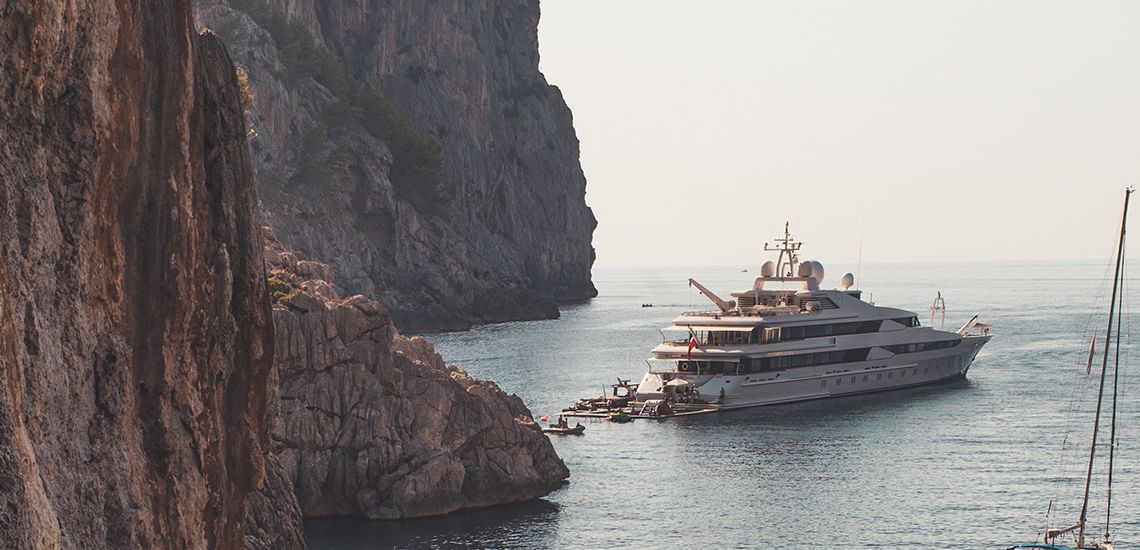
The list of tech billionaires (at least, the list we know of) is long and getting longer by the year. And as their wealth grows, so does the size of the boats they own!
Jeff Bezos, Larry Ellison (Musashi), Charles Simonyi (SKAT), Sergey Brin (Dragonfly), and Larry Page (Senses) are just some of the tech billionaires known to own a superyacht. Mark Zuckerberg, meanwhile, is rumoured to own Andromeda.
While we can only speculate on how these exact individuals use their yachts or what they are like onboard, some general traits might set the tech billionaire yacht owner out as using their yachts differently than generations of yacht owners before them.
Overall, tech billionaires are often younger, more adventurous and less hidebound regarding old rules and service styles. Here are a few general trends we can assume.
They want to eat well, but less fussily, and with a greater premium on health.

Where silver service, ultra-decadent meals, and mountains of wasted food were — and often still are— preferred by old-money yacht owners and charterers, the modern tech billionaire is more likely to be health-conscious and eat food that is plated rather than buffet style or silver service. Yacht chefs now need to be more skilled in special diets, such as plant-based or keto, and offer a broader range of cuisines.
They want to WORK.
Superyachts used to be for holidays only. This was partly by necessity —the lack of connectivity meant that work went on the back burner for summer months as guests swanned around the Mediterranean. Now, the extraordinary technological strides on board allow yacht owners to have offices where they can work anywhere in the world.
They want to go far beyond the milk run.
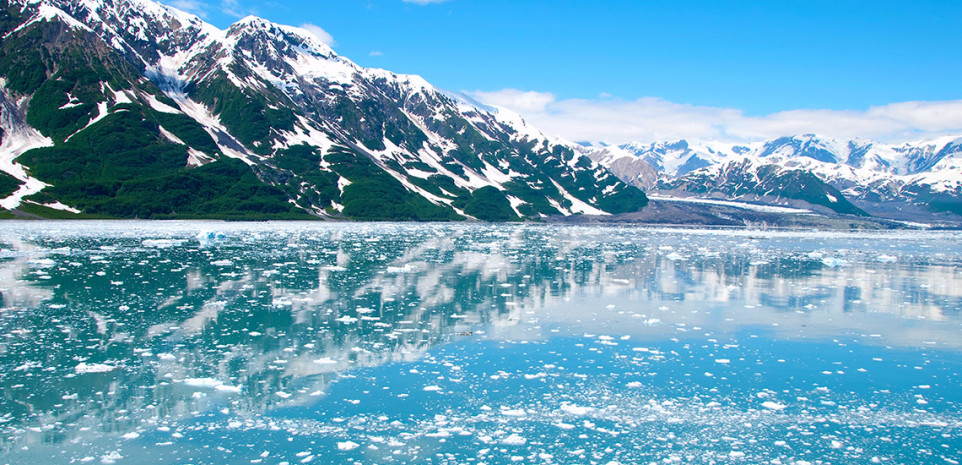
While anchoring off St Tropez or Cap Ferrat for weeks in August will always be in style, there has been an explosion in remote cruising, often fuelled by this younger, more adventurous set of yacht owners who can work from anywhere- Antarctica to Alaska and beyond.
This has fed into the next point…
A desire for adventure and exploration has changed yacht design.
As younger, more adventurous owners like tech billionaires have joined the superyacht market, the design of yachts and the toys they carry have changed markedly. New types of vessels have been created to meet this desire for off-the-beaten-track cruising, from support yachts to water toys to the massive growth in explorer yachts. Gone are the days when one yacht layout was almost identical to another. Now, we have winter gardens, submarines, ice rooms, ski rooms, large onboard offices, and helicopter hangars.
Not all of these changes have been driven by tech billionaires, granted. Still, their vision of what is possible has dramatically changed what yachts look like and how they operate as machines, with new types of propulsion, greater ranges, and a considerable amount more tech onboard.
Some things never change.
One thing hasn’t changed, though—a wealthy person’s desire for privacy. Discretion remains perhaps the most essential trait in any crew member, which you must keep in mind when working on yachts —even in the day of constant social media and shows like Below Deck.
A wealthy person’s desire for privacy and discretion is a constant that crew forget at their peril. Are you ensuring that you are a trusted asset? You may have signed that NDA, but do you let stories slip now and then at the bar? Are you careful about not taking photos onboard that give away anything about the boat or the owners? Do you make sure you don’t share the yacht’s cruising plans?
In a world where stories about tech billionaires will fly around the globe at light speed, you must be the gatekeeper. Stories cannot leave the passerelle.

Contact information
Sharon Rose
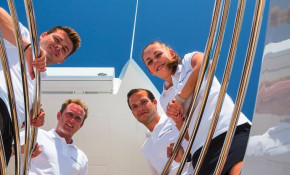
Related news

Navigating Success: Superyacht Industry Unveils Career Roadmaps with ’Raising the Bar’
Raising the Bar, a distinguished think tank comprised of experts from across the superyacht industry, is thrilled to announce the official launch of Superyacht Industry Careers. This groundbreaking initiative, developed through voluntary collaboration and graciously hosted by the Superyacht Alliance for Professional Standards, aims to provide comprehensive career maps tailored for superyacht crew across all departments.

Interview with Sheila, Founder of Source Training: Elevating Standards in Luxury Cleaning and Laundry
We had the privilege of sitting down with Sheila, the visionary founder behind Source Training, a pioneering platform that offers specialised training for luxury cleaning and laundry personnel in the yachting, chalet, and hotel industries. With decades of experience in the yachting world and a passion for preserving nature, Sheila shared her journey and insights into the need for professional training in these essential roles.
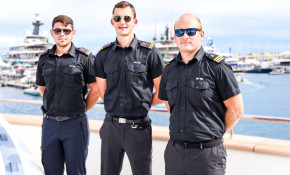
Stripes on Yachts: What Do They Mean?
Whether you are new to the yachting industry or an experienced professional, we’ve all asked ourselves the same question at least once in our career, “what do those stripes mean?” This article breaks down the meanings behind these cryptic stripes.
- Starting a Business
- Growing a Business
- Small Business Guide
- Business News
- Science & Technology
- Money & Finance
- For Subscribers
- Write for Entrepreneur
- Entrepreneur Store
- United States
- Asia Pacific
- Middle East
- South Africa
Copyright © 2024 Entrepreneur Media, LLC All rights reserved. Entrepreneur® and its related marks are registered trademarks of Entrepreneur Media LLC
The Luxury Boats Owned By Some of the Wealthiest People in Tech, from a Yacht So Big It Has Its Own Support Boat to Superyachts with Swimming Pools and Basketball Courts Tech billionaires like Jeff Bezos, Oracle cofounder Larry Ellison, and Google cofounders Sergey Brin and Larry Page have all purchased mini vacation hubs at sea.
By Grace Kay and Sindhu Sundar • Jul 3, 2023
Key Takeaways
- Many billionaires like Jeff Bezos and Richard Branson enjoy spending their time on luxurious yachts.
- The boats are decked out with amenities that many Americans can only dream of.
- Here are some of the billionaires in tech who own private yachts.
This article originally appeared on Business Insider .
A regular Jane celebrating a personal renaissance after a long-term relationship might commemorate the new era with an ankle tattoo of a spiritual saying. When you're a billionaire, you could do it instead with a $500 million megayacht .
Amazon founder Jeff Bezos made waves in May riding around the roughly 127-meter "Koru," a Māori term that may signify a fresh start, with his reported fiancée Lauren Sanchez. (In 2019, Bezos finalized his divorce from MacKenzie Scott, whom he was married to for 25 years).
Beyond the private planes occupying the hangars of billionaires, yachts have come to symbolize the highly private sites of leisure and networking reserved for the ultra-wealthy .
Tech billionaires like Bezos, Oracle cofounder Larry Ellison, and Google cofounders Sergey Brin and Larry Page have all purchased their own mini vacation hubs at sea, decking their boats with amenities like gyms, spas, pools, nightclubs, and movie theaters.
For those wishing to experience life aboard these multi-million-dollar yachts, some are available to rent out for a few nights or weeks at a time. Late Microsoft cofounder Paul Allen's yacht can be booked for $2.2 million per week or more, according Bloomberg .
Chartering yachts owned by billionaires like Alphabet cofounder Sergey Brin has previously cost customers anywhere from $773,000 a week to $1.2 million .
It remains to be seen how these vessels will fare against the apparent Orca uprising.
Take a look at some of the yachts that have been owned by tech billionaires.
A mystery buyer bought a 414-foot superyacht that was once owned by late Microsoft co-founder Paul Allen for $278 million. Allen had the boat, which was named "Octopus," built in 2003 for $200 million. Since the tech billionaire's death in 2018, the boat had been listed for as much as $325 million.

Octopus in Canary Wharf, London, in 2012. Ki Price/Reuters Source: SuperYacht Times
The wealthy can book the yacht for a weekly rate of $2.2 million or more, through the luxury company Camper & Nicholsons, Bloomberg reported last year.
414ft luxury yacht 'Octopus' owned by Microsoft co-founder, Paul Allen, is moored to fuel up at Ege Ports in Kusadasi district of Aydin, Turkey on April 27, 2015. Ibrahim Uzun/Anadolu Agency/Getty Images
Sources: Bloomberg; Insider .
Amazon founder Bezos' $500 million megayacht, the roughly 127-meter "Koru," sparked attention in May for its artistic decor. A sculpture of a woman on the boat appeared to observers to be the likeness of Bezos' reported fiancée Sanchez, who was also seen that month on the yacht sporting a large ring.
Jeff Bezos was spotted aboard his megayacht "Koru" in May. Lift Aircraft.
Even before its completion, "Koru" drew the ire of Dutch people vowing to hurl eggs at the boat if it would require a historic bridge in Rotterdam to be taken apart to let it through. An egg crisis was averted however, as the company making the ship found a less-irksome alternative.
View of the Koningshaven Bridge, known as De Hef in Rotterdam, Netherlands. Peter Dejong/AP
Bezos has long been interested in yachts. In 2019, he was spotted aboard entertainment mogul David Geffen's superyacht.
David Geffen's superyacht Flickr via BI
Oracle cofounder Larry Ellison owns a 288-foot yacht named Musashi that he acquired in 2013. The yacht has several amenities, including an elevator, swimming pool, movie theater, and both an indoor and outdoor gym.
rulenumberone2/Flickr, Justin Sullivan/Getty Images
Source: Yacht Bible
Ellison has owned several superyachts over the years, including the Katana, the Ronin, and the Rising Sun.
Courtesy of Lurssen Source: Forbes .
The Oracle cofounder also has a knack for competitive yacht racing, and helped to found and back a racing team, called Oracle Team USA, in 2000. The team has found success and won several prestigious titles over the years.
Xaume Olleros/Getty Images Sport Source: Telegraph
Ellison previously owned a bigger, 454-foot yacht called Rising Sun, which was designed specifically for the CEO in 2005. That yacht reportedly has 82 rooms, a movie theater, a wine cellar, and a basketball court. However, Ellison sold off the Rising Sun to Geffen for a reported $300 million.
Kimberly White/Getty Images Source: Forbes , Boat International
Ellison's boat, Musashi, is a sister ship to the yacht of another billionaire, former Sears CEO Eddie Lampert. However, the yacht, named Fountainhead, is often mistaken for belonging to billionaire investor Mark Cuban. "The guy who owns the boat tells everyone that it's mine," Cuban told Page Six in 2016. "It's so crazy ... I don't even own a boat."
Mark Cuban. Steve Marcus/Reuters
Source: Page Six
Ellison's yacht reportedly influenced the decision of late Apple CEO Steve Jobs to get a boat himself. However, Jobs never set foot on the boat — the yacht was commissioned in 2008, but wasn't completed until 2012, a year after his death.
Justin Sullivan/Getty Images Source: Business Insider
When Jobs died in 2011, his yacht — along with his $14.1 billion fortune — was inherited by his wife, Laurene Powell Jobs, founder and president of a social-impact nonprofit called the Emerson Collective. The 256-foot yacht is named Venus, and is worth $130 million.
AP Photo/Peter Dejong Source: Business Insider
Google's billionaire cofounders, Larry Page and Sergey Brin, are known to splurge. An Insider feature in December documented some of the trappings of their luxury, including planes and yachts.
Sergey Brin (left) and Larry Page. Getty / Michael Nagle
Source: Insider .
Page owned a yacht named Senses, a $45 million, 194-foot boat that he bought in 2011 from a New Zealand businessman. He's since sold the yacht, Insider reported in 2021, a vessel that had a private beach club with a Jacuzzi and sun beds, both indoor and outdoor dining areas, and a helicopter pad. It's unclear what other sea vessels he owns, though Insider has previously reported he might have another yacht.
Ari Helminen/Flickr, Justin Sullivan/Getty Images Sources: Boat International; Insider .
Brin meanwhile owns a number of yachts and vessels including the 73-meter Dragonfly, and the 40-meter Butterfly, Insider reported in January.
Abell Point Marina/YouTube Source: Insider .
Dragonfly, the $80 million boat that has a movie-theater, shares a name with Google's once-secret project to launch a censored search engine in China. Google said in 2019 it had officially terminated the project.
Eric Risberg/Associated Press Source: Insider , Forbes .
The former Google CEO picked up the Alfa Nero yacht for nearly $68 million in an auction in June, according to a Bloomberg report. The yacht had apparently been left amid Russia's war in Ukraine, according to the report.
Eric Schmidt REUTERS/Brian Snyder Source: Bloomberg .
For Skype cofounder Niklas Zennstrom, his interest in yachts skews toward racing and competitive sailing. Zennstrom has gone through a succession of boats all named Ran.
Co-Founder and CEO of Skype Technologies, United Kingdom Niklas Zennstroem listens during a plenary entitled 'Digital 2.0:Powering a Creative Economy' at the World Economic Forum in Davos, Switzerland, AP Photo/Michel Euler
Source: CNN
The Ran VII yacht is among the most advanced of Zennstrom's boats. The racing yacht uses electrical power, which Zennstrom has said makes it "lighter, less drag, quieter, and most importantly it is environmentally friendly."
Carkeek Design Partners/YouTube Source: CNN
The 40-foot yacht has been meant to compete in regattas through the racing team owned by Zennstrom and his wife, Catherine. The Ran racing team launched in 2008, and has won some prestigious regattas.
The Ran racing team. Carkeek Design Partners/YouTube Source: CNN
Barry Diller, chairman of digital media company IAC, co-owns a $70 million yacht with his wife, fashion designer Diane von Furstenberg.
Diane von Furstenberg, left, and Barry Diller. Scott Olson/Getty Images Source: Business Insider
The sailing yacht, named Eos, is 350 feet long with six bedrooms. The power couple has hosted many celebrities over the years — a few that have been spotted aboard Eos include model Karlie Kloss, actor Bradley Cooper, journalist Anderson Cooper, and singer Harry Styles.
snowwahine/YouTube Source: W Magazine
For Jim Clark, the cofounder of Netscape, one yacht hasn't been enough. Clark has owned boats for more than 30 years, and in 2012, he put up two of his sailing yachts for sale.
Jim Clark, right. Cameron Spencer/Getty Images Source: Business Insider
Clark listed the boats for a combined $113 million: the 136-foot Hanuman for $18 million, and the 295-foot Athena for $95 million. However, Clark has yet to offload Athena. Clark also previously owned a 155-foot yacht named Hyperion, and currently also owns a sloop called Hanuman.
The yacht Athena. Fosnez / Wikimedia Commons Source: Boat International , Forbes
Charles Simonyi worked at Microsoft until 2002, and oversaw the creation of Microsoft Office software. A few years before he left, Simonyi decided to purchase a yacht. He told the designer that wanted his yacht to be "home away from [his] home in Seattle."
Reuters/Sergei Remezov Source: Boat International
The product of that conversation in 1999 is Simonyi's yacht named Skat, meaning "treasure" in Danish. The yacht measures 233 feet long, and is unique with its nontraditional design and gray color. Skat features a matching gray helicopter, a gym, and motorcycles.
Christopher Hunt/Getty Images Source: Yacht Charter Fleet
Opulent British billionaire Richard Branson owned a yacht until he sold it in September 2018. The 105-foot catamaran sold for $3 million, significantly lower than the $9.6 million price Branson listed the boat for in 2014.
Anthony Harvey/Getty Images, Virgin Source: Business Insider
Branson, the founder of Virgin Group, bought the boat in 2009. He named it Necker Belle, a nod to his private Caribbean island, Necker Island.
Necker Island Source: Business Insider
Additional reporting by Paige Leskin.
Want to be an Entrepreneur Leadership Network contributor? Apply now to join.
Editor's Pick Red Arrow
- This 103-Year-Old Doctor Opened Her Medical Practice Before Women Could Have Bank Accounts — Here Are Her 6 Secrets to a Healthy, Successful Life
- Lock 5 Ways You Might Be Cheating on Your Taxes — And Why You Will Get Caught
- I've Had a Secret Side Hustle for Decades. It Keeps Tens of Thousands of Dollars in My Pocket — and Gets Me Into Places I Wouldn't Go Otherwise .
- Lock Here's How Steve Jobs Dealt With Negative Press and Avoided Brand Disasters
- One Factor Is Helping This Entrepreneur Tackle Business Ownership Later in Life. Now, She's Jumping Into a $20 Billion Industry .
- Lock Narcissism Can Help You Be Successful — Here's How to Harness It Without Going Too Far, According to an Ivy League-Trained Psychotherapist
Most Popular Red Arrow
This dad started a side hustle to save for his daughter's college fund — then it earned $1 million and caught apple's attention.
In 2015, Greg Kerr, now owner of Alchemy Merch, was working as musician when he noticed a lucrative opportunity.
I Designed My Dream Home For Free With an AI Architect — Here's How It Works
The AI architect, Vitruvius, created three designs in minutes, complete with floor plans and pictures of the inside and outside of the house.
7 Link-Building Tactics You Need to Know to Skyrocket Your Website's Rankings
An essential component of SEO, link building is not just a 'Set them and forget them' proposition, but a dance of skills and strategies.
Clinton Sparks Podcast: Beverly Hills 90210 and Entrepreneurship with Brian Austin Green
Brian Austin Green shares profound lessons he's learned growing up in the entertainment industry.
This Fan-Favorite Masters 2024 Item Is Still $1.50 as Tournament Menu Appears Unscathed by Inflation
The pimento cheese sandwich is a tradition almost as big as the tournament itself.
Disney World, Disneyland Will Now 'Permanently' Ban Guests Who Tell This Lie to Skip Lines
The company rolled out changes to its Disability Access Services earlier this week.
Successfully copied link
Glusea| Celebrity Net Worth, Finance, Wealth & Rich List

Top 10 billionaires and their yachts in 2022
Mega Yachts are the ultimate expression of luxury, sophistication, and extravagance.
Some are equipped with cinemas, helipads, concert halls, and even beaches on board; others are the garage of other smaller boats, mini-submarines, and a whole sports club.
Without a doubt, these mega yachts show us how to live a true life of luxury. But in order to live beautifully and with taste it is not necessary to have such an expensive boat. Drop anchor in a beautiful bay, put on nice clothes, pour wine into expensive glasses and watch the sunset. A romantic sunset on your own boat, even if not very expensive, will be no worse than a millionaire’s, and maybe even better. But if you do not have a boat, then it will be difficult to enjoy the beauty of the sunset, not accessible from the shore. In this case, Zeboats will help you, here are yachts and motor boats for every taste and price.
Here are the “Top 10” of the most expensive mega yachts in the world, owned by Russian oligarchs, royals, billionaires, and more:
10. Lady Moura
Table of Contents
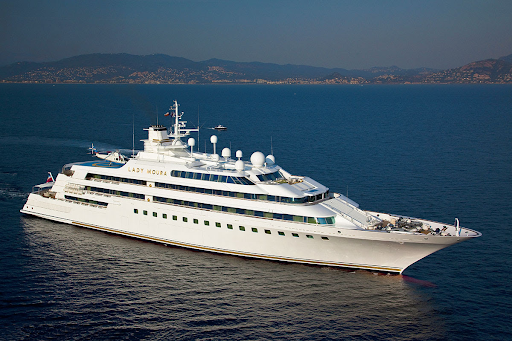
Cost: $ 210 million (€ 185 million)
Owner: Nasser Ibrahim Al-Rashid
Lady Moura is a luxurious 105-meter (344-foot) private mega-yacht owned by Saudi billionaire Nasser Ibrahim Al-Rashid, considered one of the most influential advisers to the royal family of Saudi Arabia.
In addition to having her name and shield in 24-karat gold, the Lady Moura also includes a pool with a retractable roof.
But, without a doubt, the most impressive aspect of this mega yacht is its Beach Club.
Lady Moura has hosted great personalities from around the world, including former US President George H. W. Bush and his wife Barbara.
9. Rising Sun

Cost: $ 290 million (€ 255 million)
Owners: Larry Ellison and David Geffen
The actor, Leonardo DiCaprio, is one of the celebrities who has been seen aboard this boat.
Rising Sun is a luxury yacht designed by Jon Bannenberg, and built by the German shipyard Lürssen. Currently, the mega yacht is co-owned by Larry Ellison, founder of Oracle Corporation, along with David Geffen.
The yacht is considered the # 11 largest in the world with a length of almost 138 meters (453 feet).
Rising Sun has 8,000 square meters of space and 82 rooms spread over its five levels.
This mega yacht has a basketball court on the main deck (which can be used as a helicopter platform if necessary), plus another helipad.
It also features Onyx countertops, Jacuzzi baths, a gym/spa and sauna, a large wine cellar, and a private cinema with a giant plasma screen.

Cost: $ 300 million (€ 262 million)
Owner: Sammy Tak Lee
Pelorus is the fourteenth largest luxury yacht in the world at 115 meters (377 feet) in length. It was designed by Tim Heywood and built by Lürssen in Bremen, Germany in 2003.
It was briefly owned by a Saudi businessman who sold it to Russian billionaire Roman Abramovich. After buying it, Abramovich ordered the German shipyard Blohm & Voss to adapt it to his own needs.
These adaptations included a second forward helipad, four new speed stabilizers, and modifications to the exhaust, mast, and stern.
Details about the interiors are scarce, as the Russian oligarch is well known for being a protector of the privacy of his family and very security conscious.
“This mega yacht is so huge that it also has a mini-collection of small boats.”
The master suite has a movable wall, which can be lowered and transformed into a private terrace. Impressive!
Irina Abramovich received this yacht in 2009 as part of her divorce agreement with the Russian billionaire. In 2011, Abramovich’s ex-wife sold her through brokerage Merle Wood to American business magnate and producer David Geffen for $ 300 million.
In 2011, Geffen sold Pelorus to the Foreign Minister of the United Arab Emirates, Sheikh Abdullah bin Zayed bin Sultan Al Nahyan, for € 214 million ($ 188 million).
In 2016, Pelorus was sold to Chinese billionaire Samuel Tak Lee. According to Forbes, Tak Lee has an estimated net worth of $ 3.9 billion.
7. Motor Yacht ‘A’

Cost: $ 300 million
Owner: Andrey Melnichenko
The name “A” was chosen so that this fabulous vessel would always appear first in the shipping records.
This 120-meter (394-foot) mega-yacht, one of the most famous in the world, was designed by Philippe Starck and hatched by architect Martin Francis.
‘A’, owned by Russian magnate Andrey Melnichenko, has a 2,500-square-foot main room, six suites, and versatile interior spaces thanks to glass and sliding walls.
At 119 meters (~ 390 feet) long and displacing nearly 6000 tons, ‘A’ is one of the largest yachts in the world.
This mega yacht can accommodate a total of 14 guests and has 35 crew members on board. ‘A’ has a maximum speed of 23 knots and a cruising speed of 19 knots.

Cost: $ 305 million (€ 267 million)
Owner: Sultan Qaboos of Oman
Al Said is another of the most impressive mega yachts in the world. Its interiors were designed by Redman Whiteley Dixon and it has enough facilities to accommodate up to 70 people.
Perhaps the most opulent thing about this mega yacht is its concert hall, large enough to house an orchestra of 50 musicians.
Al Said was launched by the Lürssen shipyard in September 2007, and at the time of her launch, she was the second-longest yacht in the world.
The yacht was completed in the following months and was handed over to its owners in 2008 by the Sultan of Oman, Qabus bin Said al Said.

Cost: $ 330 million (€ 290 million)
Owner: Saudi Crown Prince Mohamed bin Salman
In 2010, the Russian billionaire, Yuri Shefler, entrusted Ficanteri to create his spectacular private yacht “Serene”.
A year later, in August 2011, the Italian shipyard delivered the new megayacht to the Russian oligarch.
The vessel has no less than 4,459 square meters of space spread over seven decks, with a fully equipped spa, movie theater, and even a wood-burning pizza oven.
Serene is 133.9 meters (439 feet) long.
In 2015, Serene was sold to the Crown Prince of Saudi Arabia, Mohamed bin Salmán, for an amount of $ 550 million, about 483 million euros.

Cost: $ 400 million (€ 357 million)
Owner: Sheikh Mohammed bin Rashid Al Maktoum
This 162-meter (524-foot) megayacht is the third-largest private vessel in the world.
It is owned by Sheikh Mohammed bin Rashid Al Maktoum, ruler of the Emirate of Dubai, and current Prime Minister of the United Arab Emirates (UAE).
It has seven magnificent terraces perfect to relax and a small submarine to explore life under the sea. It was built by the German shipyard Blohm & Voss.

Cost: $ 600 million (€ 527 million)
Owner: Alisher Usmanov
Dilbar is currently the best definition of elegance and glamor at sea.
The 156-meter (512-foot) long mega yacht was built by the German shipyard Lürssen.
Dilbar is the largest private vessel in the world, by interior volume (Azzam is longer but with less volume).
Dilbar was handed over to her owner, Uzbek-born Russian magnate Alisher Usmanov, in May 2016. The huge yacht was designed by Espen Oeino.
Powered by a gigantic 30,000 kW ‘Diesel’ electric motor, this superyacht is capable of sailing at speeds of up to 22.5 knots.
She seats 40 people and has a crew of at least 80.
Despite being surrounded by the ocean itself, Dilbar’s designers did not skimp on their 180 cubic meter indoor pool, the largest ever built inside a yacht.

Cost: $ 600 million
Owner: Sheikh Khalifa bin Zayed Al Nahyan
Although Azzam is not the most expensive private mega yacht in the world, it is the largest (in length) in the world.
This monster of a length of 179.8 meters (590 feet), is capable of reaching an impressive top speed of almost 30 knots. Azzam was manufactured by Lürssen Yachts.
Launched in 2013, Azzam is owned by Sheikh Khalifa bin Zayed Al Nahayan, President of the United Arab Emirates (UAE) and Emir of Abu Dhabi.

Cost: $ 1.5 billion (€ 1.31 billion)
Owner: Roman Abramovich
Owned by Russian billionaire Roman Abramovich, Eclipse is the most expensive megayacht on this list.
It is a monstrous vessel measuring 170 meters (560 feet) in length, a size that makes it the second-largest private yacht in the world.
Eclipse has two helipads, 11 guest cabins, two pools, several Jacuzzis, and a disco room, she also comes equipped with three tenders, and a mini-submarine that is capable of diving to 50 meters.
Approximately 70 crew people are required for the operation of the huge vessel.
And how could it be otherwise, including security reasons, Eclipse is equipped with intrusion detection systems and a German-made anti-missile defense system.
The windows in Mr. Abramovich’s master bedroom are also fitted with armored glass.
Eclipse was built by Blohm + Voss, the renowned shipbuilder based in Hamburg, Germany.
Roman Abramovich also owns two other mega yachts, “Ecstasea”, and “Le Grand Bleu”, the latter given to a friend of his named Eugene Shvidler.
- The Woodlands
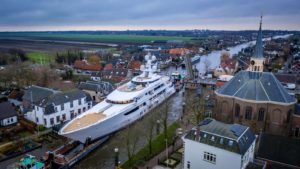
Tilman Fertitta's 252-foot, $150 million superyacht Boardwalk courses through canals after departing Feadship's Aalsmeer shipyard in The Netherlands on its way to sea trials. (Photo courtesy of Feadship)
Tilman Fertitta's Boardwalk by Feadship encountered 19 locks and bridges on its way to sea trials. (Photo courtesy of Feadship)
Momus Queen Blayne Fertitta and Tilman Fertitta in 2019 partying port side of his first Boardwalk yacht during The San Luis Salute in Galveston. (Gary Fountain Photo)
The Feadship team moves Tilman Fertitta's super yatch, Boardwalk, through the narrow canals of The Netherlands on its way to sea trials. (Photo courtesy of Feadship)
An areal view of Tilman Fertitta's Feadship Boardwalk of which he is expected to take possession in April. (Photo courtesy of Feadship)
Tilman Fertitta's super yacht, Boardwalk, by Feadship makes a beautiful departure as it heads for sea trials.
Tilman Fertitt's 77-meter Boardwalk from Feadship passes the last bridge on the to sea trials, passing the city of Rotterdam. (Photo courtesy of Feadship)⠀
Tilman Fertitta Gets a New $150 Million Super Yacht — Take a Look at the Floating Paradise
Houston billionaire adds boardwalk to his empire.
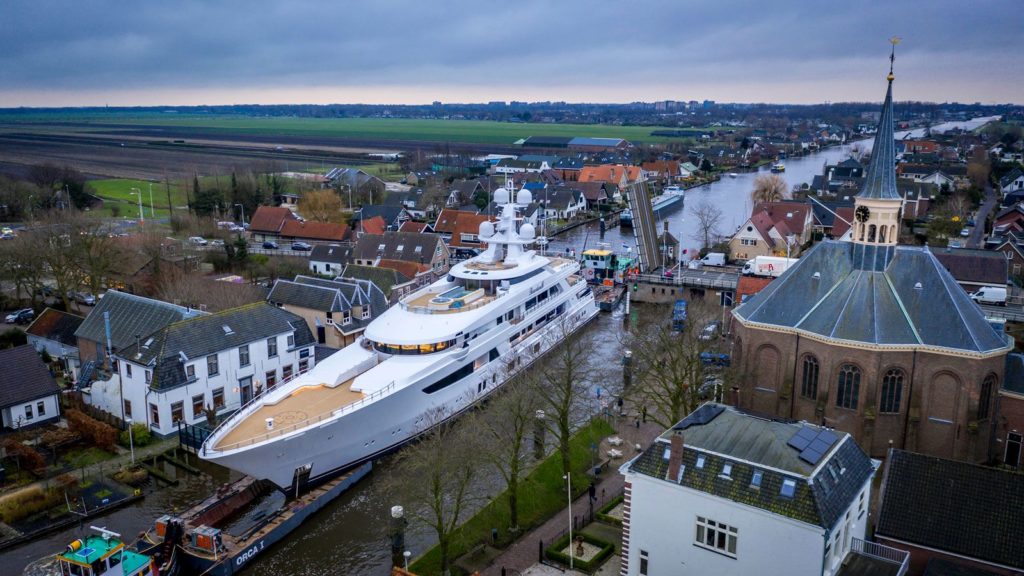
I n the stratospheric world of billionaire Tilman Fertitta, more is more. And bigger is better. Consider the hospitality mogul’s ever-expanding business empire and then add his newest toy — a superyacht set to splash through the waters of the Med in April.
Our curiosity was piqued when we saw info on a 77 meter (252 foot) Feadship yacht that “was commissioned by an experienced yachtsman, the project has been designed by De Voogt Naval Architects,” according to Boat International . The extraordinary yacht’s launch has additionally captured the attention of Super Yacht Times , Mega Yacht News , and Yacht Harbor .
The name of the floating behemoth: Boardwalk . The same name as Fertitta’s 50 meter (163 feet) Westport motor yacht that has ridden the Fertitta family across waves of the Mediterranean and the Caribbean for a decade.
A little more research reveals that indeed the new vessel, which is headed this month for sea trials, was commissioned by Fertitta in 2016. Four years is fairly standard for yacht construction from the hull up. It was launched from the Feadship’s Aalsmeer shipyard in The Netherlands and in early January.
With an estimated price tag of $150 million, the yacht has seven staterooms, a swimming pool, and, of course, a helipad accommodating Fertitta’s favored mode of travel.
The original Boardwalk remains in Fertitta’s possession and there is no indication that he will sell or charter it. As he has often said, he has no intention of letting anyone but family rest their heads on Boardwalk pillows. We would guess that deep-pocketed Fertitta will keep the smaller yacht in the Caribbean where the larger yacht would have difficulty maneuvering through the waters there.
Outdoor Dining with Bering's

In the world of superyachts , Boardwalk is a serious contender but falls short of the ridiculously huge mega yachts such as Dallas Cowboys owner Jerry Jones’ Bravo Eugenia, which measures 356 feet, or the 351-foot Benetti Lana, which charters for $1.9 million a week.
Get a closer look at Tilman Fertitta’s new yacht in this video:
What To Watch
Tv shows and movies we're watching right now.

The 5 Best New TV Shows to Stream Right Now — Apple TV+, Hulu, and Showtime Gems

The Best New TV Shows Based on Books to Stream in 2024 — Apple TV+, Peacock, Hulu, Netflix, and More Picks

The 5 Best New TV Shows to Stream Right Now — Apple TV+, Max, Hulu, Amazon Prime, and Netflix Picks

The Best New TV Shows to Stream Right Now — Favorite Netflix and Hulu Picks

5 New Movies to Stream Right Now on Netflix, Max, and Apple TV+

The Best New TV Shows to Stream Right Now — Hulu, Showtime, and Paramount+ Picks
Visit dallas' premier open-air shopping and dining destination..

Featured Properties


3006 Winchester Ranch Trail Katy, TX

902 Jolen Court Bellaire, TX

4208 Schuler Street #A Houston, TX

3838 Olympia Drive Houston, TX
_md.jpg)
2047 Westcreek Lane #807 Houston, TX

5429 Denmark Street Houston, TX

18203 Surrey Lake Lane Richmond, TX

6107 Stilson Branch Lane Houston, TX

14039 Saint Marys Lane Houston, TX

5413 Petty Street #A Houston, TX

12634 Briar Patch Road Houston, TX

734 E 13th 1/2 Street Houston, TX

504 Woodland Street Houston, TX

701 Bering Drive #1905 Houston, TX

1205 Nantucket Drive Houston, TX

6249 Locke Lane Houston, TX

3023 Wellspring Lake Drive Fulshear, TX

1203 Nantucket Drive Houston, TX
_md.jpg)
1505 Early Lane Houston, TX

1405 Dart Street Houston, TX

4413 Verdome Lane Houston, TX

6026 Lake Bridge Lane Manvel, TX

3500 Audubon Place Houston, TX

26407 Hollow Stone Lane Cypress, TX

18718 Luby Creek Drive Cypress, TX

8 Sweetwater Court Sugar Land, TX

2215 Driscoll Street Houston, TX

3317 New Garden View Lane Houston, TX

209 E Woodland Street 1/2 Houston, TX

19819 Sonterra Lane Richmond, TX

5722 Cheltenham Drive Houston, TX

Like PaperCity Dallas on Facebook
Beyond the magazine. Get more of Dallas’ top restaurant, real estate, society, fashion and art in your news feed.
Create a free account to save your favorite PaperCity content in one curated collection.
Email Address *
Password *
Create Account
Already have an account? Login
Login to your account
Remember me
Lost your password?
Don't have an account? Create Account
Create a free account to view all PaperCity recipes. Save all of your favorite content in one curated collection.
Get PC Daily delivered directly to your inbox – don't miss anything!
Search PaperCityMag.com
- International edition
- Australia edition
- Europe edition
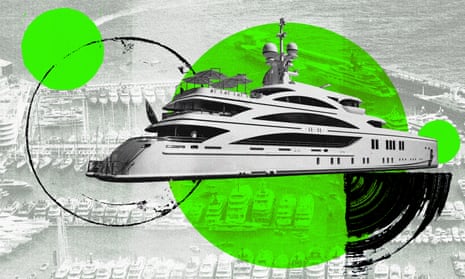
‘I cannot stress too much about it’: Monaco yacht buyers shrug off climate concerns
At annual yacht show, only a handful of customers said they were troubled by vessels’ disproportionate carbon footprint
T he largest of the yachts in Monaco’s harbour were worth more than the annual GDP of some small island states. But few of the customers touring their decks seemed to care that buying the former would help drown the latter. “I don’t think about this yet,” said Elena Papernaya, an artist who had set her eyes on a mid-sized yacht, when asked if she worried about the damage it would do to the climate.
Kasper Hojgaard, a regional manager for an industrial company who charters yachts for a few weeks each year, said he did not consider climate change “at all” when doing so. His friend Lasse Jensen, a pension fund manager, nodded in agreement. “We are beginning to look a bit more into it, but it’s not playing a role.”
The Monaco yacht show is one of the greatest concentrations of wealth in the world. The event, which calls itself “the ultimate gathering of maritime luxury”, takes place in a tax haven where two in three residents are millionaires. When the Guardian visited in late September, the port was filled with more than 100 superyachts, some of which boasted submersibles and swimming pools. Visitors could book airport transfers in private jets and helicopters.
The true cost of such luxury is paid for, in part, by the rest of society. The top 10% of earners in the EU emit 24.5 times as much planet-heating CO 2 through their transport as the bottom 10% do, according to new data from the International Energy Agency . At the extreme end of the spectrum, the carbon footprints of the ultra-rich are inflated by giant yachts, private jets and sports cars with engines that burn barrels of oil.
“There is no other way,” said Christian Largura, an Instagram star and founder of a luxury retail site who was about to buy a superyacht that runs on diesel. “For sure, if it’s possible, you take the green one … [but] if you want a big one, there is nothing fully electric.”
Billionaires’ consumption emissions run to thousands of tonnes a year, with transport, including private jets and yachts, by far the biggest contributor, according to Oxfam’s new report on carbon inequality . And transport, especially car use, is a major factor in the disproportionately high emissions of the richest 10% too, with these emissions 20-40 times higher than among the poorest 10% in major nations and blocs including the EU, according to the IEA.
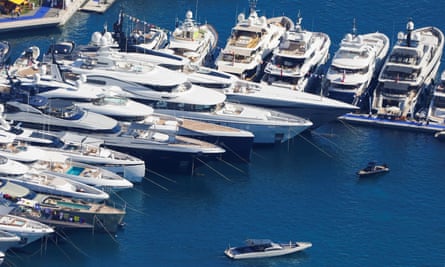
A superyacht, or even a medium-sized motor yacht, is the most polluting single object a person can own. There are no reliable estimates of how much carbon the world’s 6,000 superyachts pump into the atmosphere but one study of billionaires’ footprints found yachts were the single biggest contributor, ahead of private jets.
“Even a mansion on a private island has less impact because it is at least stuck in one place,” said Richard Wilk, of the Open Anthropology Institute, who co-wrote the study.
In interviews with 50 visitors to the Monaco yacht show – from brokers and buyers to suppliers and sellers – yacht enthusiasts painted a picture of an industry taking small steps to clean up amid growing public pressure. But only a handful of owners and customers who spoke to the Guardian said they were troubled by the disproportionate emissions their boats spewed today.
“You know that it’s something to worry about, but then again there are so many problems that we cannot fix,” said Giorgia Covolio, whose husband owns a yacht. “If I cannot solve it myself then I cannot stress too much about it.”
Jennifer Rodriguez, a friend, agreed. “If Bill Gates doesn’t stress about it, or Leonardo DiCaprio, then we won’t stress about it.”
While a small sailing ship may emit little more carbon than that required to build it and break it down, big motor boats burn vast amounts of fuel to cross seas and run power-hungry services such as air conditioning and desalination. According to a presentation by the industry group Water Revolution Foundation, the global yacht fleet spends a quarter of its energy on propulsion and three-quarters on “hotel load”. Some superyachts guzzle fuel even when docked because their crews live onboard all year round.
“The trend in yacht size goes towards bigger, bigger and bigger,” said Lina Odhe, of SF Marina, a company that supplies to increasingly crowded marinas. The industry had moved “from superyachts to megayachts to gigayachts”.
The course that yachtmakers are charting is similar to one that the auto industry has navigated for several years. Carmakers have flooded the market with bulkier vehicles at such speed – and consumers have snapped them up so fast – that nearly half of cars sold last year were SUVs, according to the IEA. Experts put part of the success down to marketing campaigns that appeal to a desire for status and power.
By the dazzling waters of Monaco’s Port Hercules, surrounded by multistorey ships and smooth-talking sales teams, most yacht owners and buyers approached by the Guardian declined to comment on their carbon footprints. Those who agreed to did so mostly on the condition of anonymity.
after newsletter promotion

One owner verbally abused and physically threatened the reporter during a half-hour interview. Two potential buyers denied the scientific consensus that humans have heated the planet by burning fossil fuels.
Several attenders used identical arguments to those from regular rich people defending habits such as flying on holiday or driving an SUV. Some said their carbon footprints were not as big as those of even richer people. Others pointed to sources of pollution that were bigger in absolute terms, such as cargo ships, factories and multinational corporations.
A handful of owners said they were aware of their own carbon footprints and frustrated at how little others had done to shrink theirs. “It’s one of the most unsustainable industries in the world, there’s no doubt about it,” said Frederik, a sustainability student from a yacht-owning family, gesturing at the port with a flute of champagne. “You’ve got here maybe three boats in total that are really trying to reduce their impact on the environment.”
He said his family had shrunk their yacht fleet down to two big boats, put solar panels and electric batteries on them and stopped dropping heavy anchors in areas with fragile seagrass that suck up carbon. “You need to make sure you’re having less of an impact every time that you use it.”
Jonathan, a friend working in luxury management, said he understood criticism of the industry but he distinguished between people who bought big yachts to show off and those who wanted to spend private time with their families. He paused before adding: “The most valuable moments I’ve had were on the boat.”
The yacht industry has started to pay more attention to the environment. This year’s Monaco yacht show featured a catamaran covered in solar panels and boasted a “sustainability hub” for the second year in a row. Among the stalls were companies trying to power yachts with electricity and methanol instead of fossil fuels, as well as some trying to increase the efficiency of engines and hulls.
Javier Navarro, a broker with Zarpo Yachts, said the average age of a yacht owner had fallen to 42, and the younger generation of owners were more concerned about climate change. At the same time, advances in clean technologies in other sectors – such as car batteries getting smaller and cheaper – had made it feasible to electrify small yachts. “They are taking a lot of innovations from the car industry into the boating sector,” he said.
Some visitors were sceptical of the green marketing and the buyers nodding along to it. One crew member on a charter yacht said clients on her ship sometimes asked if the water they served came from plastic bottles, but did not mind spending weeks on a boat that guzzles fossil fuels. “I guess it’s nice to try to do what you can with the little things,” she said. “But really they’re scratching the surface.”
The total emissions from the yacht industry are probably a fraction of the overall shipping industry’s, experts say, but are caused by a far smaller group of people pursuing what is almost exclusively a leisure activity. And social scientists warn that the carbon footprints of the super-rich go beyond their raw emissions. Many people aspire to their lifestyles, particularly when glamorised in social media posts, and their emissions are often used by those with smaller footprints to justify polluting habits.
A junior associate at a law firm who lives in Monaco and was not attending the yacht show told the Guardian that the thought of such inequality frustrated her. “We make all these efforts in our own lives but when you see that” – she broke off and pulled a face at a row of superyachts hosting parties behind her – “well, it’s completely delirious.”
- Travel and transport
- The great carbon divide
- Greenhouse gas emissions
- Climate crisis
- The super-rich
Most viewed
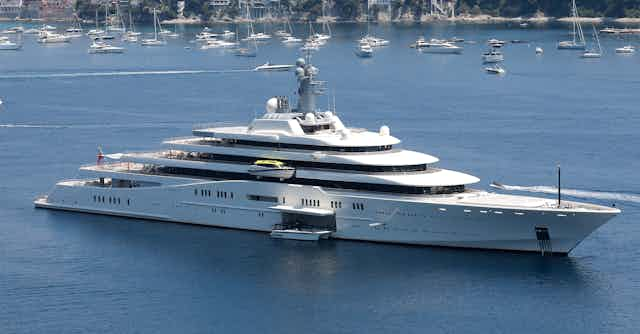
Private planes, mansions and superyachts: What gives billionaires like Musk and Abramovich such a massive carbon footprint
Distinguished Professor and Provost's Professor of Anthropology; Director of the Open Anthropology Institute, Indiana University
Ph.D. Candidate in Anthropology, Indiana University
Disclosure statement
The authors do not work for, consult, own shares in or receive funding from any company or organisation that would benefit from this article, and have disclosed no relevant affiliations beyond their academic appointment.
Indiana University provides funding as a member of The Conversation US.
View all partners
- Bahasa Indonesia
Tesla’s Elon Musk and Amazon’s Jeff Bezos have been vying for the world’s richest person ranking all year after the former’s wealth soared a staggering US$160 billion in 2020, putting him briefly in the top spot .
Musk isn’t alone in seeing a significant increase in wealth during a year of pandemic, recession and death. Altogether, the world’s billionaires saw their wealth surge over $1.9 trillion in 2020, according to Forbes.
Those are astronomical numbers, and it’s hard to get one’s head around them without some context. As anthropologists who study energy and consumer culture, we wanted to examine how all that wealth translated into consumption and the resulting carbon footprint.
Walking in a billionaire’s shoes
We found that billionaires have carbon footprints that can be thousands of times higher than those of average Americans.
The wealthy own yachts, planes and multiple mansions, all of which contribute greenhouse gases to the atmosphere. For example, a superyacht with a permanent crew, helicopter pad, submarines and pools emits about 7,020 tons of CO2 a year, according to our calculations, making it by the far worst asset to own from an environmental standpoint. Transportation and real estate make up the lion’s share of most people’s carbon footprint, so we focused on calculating those categories for each billionaire.

To pick a sample of billionaires, we started with the 2020 Forbes List of 2,095 billionaires. A random or representatives sample of billionaire carbon footprints is impossible because most wealthy people shy away from publicity , so we had to focus on those whose consumption is public knowledge. This excluded most of the superrich in Asia and the Middle East .
We combed 82 databases of public records to document billionaires’ houses, vehicles, aircraft and yachts. After an exhaustive search, we started with 20 well-known billionaires whose possessions we were able to ascertain, while trying to include some diversity in gender and geography. We have submitted our paper for peer review but plan to continue adding to our list.
We then used a wide range of sources, such as the U.S. Energy Information Administration and Carbon Footprint , to estimate the annual CO2 emissions of each house, aircraft, vehicle and yacht. In some cases we had to estimate the size of houses from satellite images or photos and the use of private aircraft and yachts by searching the popular press and drawing on other studies . Our results are based on analyzing typical use of each asset given its size and everything else we could learn.
We did not try to calculate each asset’s “ embodied carbon ” emissions – that is, how much CO2 is burned throughout the supply chain in making the product – or the emissions produced by their family, household employees or entourage. We also didn’t include the emissions of companies of which they own part or all, because that would have added another significant degree of complexity. For example, we didn’t calculate the emissions of Tesla or Amazon when calculating Musk’s or Bezos’ footprints.
In other words, these are all likely conservative estimates of how much they emit.
Your carbon footprint
To get a sense of perspective, let’s start with the carbon footprint of the average person.
Residents of the U.S., including billionaires, emitted about 15 tons of CO2 per person in 2018. The global average footprint is smaller, at just about 5 tons per person.
In contrast, the 20 people in our sample contributed an average of about 8,190 tons of CO2 in 2018. But some produced far more greenhouse gases than others.
The jet-setting billionaire
Roman Abramovich, who made most of his $19 billion fortune trading oil and gas, was the biggest polluter on our list. Outside of Russia, he is probably best known as the headline-grabbing owner of London’s Chelsea Football Club.

Abramovich cruises the Mediterranean in his superyacht, named the Eclipse , which at 162.5 meters bow to stern is the second-biggest in the world, rivaling some cruise ships. And he hops the globe on a custom-designed Boeing 767 , which boasts a 30-seat dining room. He takes shorter trips in his Gulfstream G650 jet, one of his two helicopters or the submarine on his yacht.
He maintains homes in many countries, including a mansion in London’s Kensington Park Gardens, a chateau in Cap D’Antibes in France and a 28-hectare estate in St. Barts that once belonged to David Rockefeller . In 2018, he left the U.K. and settled in Israel , where he became a dual citizen and bought a home in 2020 for $64.5 million.
We estimate that he was responsible for at least 33,859 metric tons of CO2 emissions in 2018 – more than two-thirds from his yacht, which is always ready to use at a moment’s notice year-round.
Massive mansions and private jets
Bill Gates, currently the world’s fourth-richest person with $124 billion, is a “modest” polluter – by billionaire standards – and is typical of those who may not own a giant yacht but make up for it with private jets.

Co-founder of Microsoft, he retired in 2020 to manage the Bill and Melinda Gates Foundation, the world’s largest charity, with an endowment of $50 billion.
In the 1990s, Gates built Xanadu – named after the vast fictional estate in Orson Welles’ “Citizen Kane” – at a cost of $127 million in Medina, Washington. The giant home covers 6,131 square meters, with a 23-car garage, a 20-person cinema and 24 bathrooms. He also owns at least five other dwellings in Southern California, the San Juan Islands in Washington state, North Salem, New York, and New York City, as well as a horse farm , four private jets, a seaplane and “a collection” of helicopters .
We estimated his annual footprint at 7,493 metric tons of carbon, mostly from a lot of flying.
The environmentally minded tech CEO
South African-born Elon Musk, CEO of Tesla Motors and SpaceX, has a surprisingly low carbon footprint despite being the world’s second-richest person, with $177 billion – and he seems intent on setting an example for other billionaires .

He doesn’t own a superyacht and says he doesn’t even take vacations .
We calculated a relatively modest carbon footprint for him in 2018, thanks to his eight houses and one private jet. This year, his carbon footprint would be even lower because in 2020 he sold all of his houses and promised to divest the rest of his worldly possessions .
While his personal carbon footprint is still hundreds of times higher than that of an average person, he demonstrates that the superrich still have choices to make and can indeed lower their environmental impact if they so choose.
His estimated footprint from the assets we looked at was 2,084 tons in 2018.
The value of naming and shaming
The aim of our ongoing research is to get people to think about the environmental burden of wealth.
While plenty of research has shown that rich countries and wealthy people produce far more than their share of greenhouse gas emissions, these studies can feel abstract and academic, making it harder to change this behavior.
[ Like what you’ve read? Want more? Sign up for The Conversation’s daily newsletter .]
We believe “shaming” – for lack of a better word – superrich people for their energy-intensive spending habits can have an important impact, revealing them as models of overconsumption that people shouldn’t emulate.
Newspapers, cities and local residents made an impact during the California droughts of 2014 and 2015 by “drought shaming” celebrities and others who were wasting water, seen in their continually green lawns . And the Swedes came up with a new term – “ flygskam ” or flying shame – to raise awareness about the climate impact of air travel.
Climate experts say that to have any hope of limiting global warming to 1.5 degrees Celsius above preindustrial levels, countries must cut their emissions in half by 2030 and eliminate them by 2050.
Asking average Americans to adopt less carbon-intensive lifestyles to achieve this goal can be galling and ineffective when it would take about 550 of their lifetimes to equal the carbon footprint of the average billionaire on our list.
- Climate change
- Carbon emissions
- Carbon footprint
- Paris Agreement
- Billionaires
- Roman Abramovich

Faculty of Law - Academic Appointment Opportunities

Operations Manager

Senior Education Technologist

Audience Development Coordinator (fixed-term maternity cover)

Lecturer (Hindi-Urdu)
Iranian special forces seize cargo vessel in a key shipping lane, state media reports

Iranian special forces seized a container ship near the Strait of Hormuz, a key shipping lane to the Persian Gulf, the state-run IRNA news agency reported Saturday.
Navy special forces from the Islamic Revolutionary Guard Corps used a helicopter to board and seize a container ship, IRNA news reported, adding that the MSC Aries was being transferred to Iranian territorial waters.
Video on the state-owned news network Press TV showed what it said were people using a rope to drop onto the ship. NBC News could not independently verify the footage.
The move could escalate tensions in a region reeling from the war in Gaza and a recent strike, suspected to have been carried out by Israel, that killed senior Iranian military officers. Since Hamas’ deadly Oct. 7 terror attack and mass hostage taking and Israel’s subsequent full-scale assault on the Gaza Strip, more than 33,000 people have been killed and 75,000 others have been injured.
And attacks by Iran-backed Houthi militants on ships in the Red Sea have already rocked global trade as several major shipping lines and oil transporters suspended their services through the waterway.
As companies avoid the Suez Canal, which feeds into the Red Sea, and opt instead to go around Africa to get to the Indian Ocean, it can add up to 14 days to a shipping route, incurring higher fuel costs. And since ships take a longer time to get to their destinations, delays in container and commodity deliveries are inevitable.
IRNA said the Portuguese-flagged ship was operated by the Zodiac shipping company, which is part of Israeli billionaire Eyal Ofer’s Zodiac Group. Zodiac said in a statement that the ship is managed and operated by the U.K.-based shipping company, MSC, which confirmed Saturday that the MSC Aries had been “boarded by Iranian authorities via helicopter.” The shipping company also said there were 25 crew members onboard and that it is working with “relevant authorities” to ensure their safety.
Iranian authorities did not immediately issue a public statement on the incident.
The United Kingdom Maritime Trade Operations agency said on X that the MSC Aries had been seized 50 nautical miles northeast of the Fujairah, an area close to the Strait of Hormuz that forms the entrance to the Persian Gulf.
When asked by NBC News, the Israeli government said it had no comment on the ship’s seizure. But Israel Katz, the country’s foreign minister, said on X that Iran was “now conducting a pirate operation in violation of international law.”
In a separate statement Saturday that was not in response to the incident unfolding in the Strait of Hormuz, Israeli military spokesperson Rear Adm. Daniel Hagari said that Iran would “bear the consequences for choosing to escalate the situation any further.”
“Israel is on high alert. We have increased our readiness to protect Israel from further Iranian aggression. We are also prepared to respond,” he said.
The attack comes after a strike, suspected to have been carried out by Israel, on the Iranian consular building in the Syrian capital of Damascus earlier this month. Israel did not take responsibility for that strike, but Tehran vowed revenge.
Brig. Gen. Mohammad Reza Zahedi, a senior member of the Quds Force, the Islamic Revolutionary Guard Corps ’ elite foreign espionage group, was killed in the blast. He was the most senior Iranian official to be killed since Gen. Qassem Soleimani was targeted by an American airstrike in 2020.
Five military advisers in the IRGC, Iran’s immensely powerful military and political organization, were also killed in the attack. While Israel and Iran have avoided direct conflict for years, the IRGC has helped Tehran wage a shadow war with Israel across the Middle East.
After the attack, Iran’s supreme leader, Ayatollah Ali Khamenei , said at a prayer ceremony celebrating the end of the Muslim holy month of Ramadan on Wednesday that Israel “must be punished, and it will be punished.” Since the building destroyed was a consular building, he said, it amounted to an attack on Iranian soil.
The United States has signaled its support for Israel and worked to persuade Iran to stop short of a significant escalation. While increasingly critical of the way Israel is pursuing the war in Gaza, President Joe Biden has pledged that America’s “commitment to Israel’s security against these threats from Iran and its proxies is ironclad.”
Henry Austin is a senior editor for NBC News Digital based in London.
- Work & Careers
- Life & Arts
Become an FT subscriber
Try unlimited access Only $1 for 4 weeks
Then $75 per month. Complete digital access to quality FT journalism on any device. Cancel anytime during your trial.
- Global news & analysis
- Expert opinion
- Special features
- FirstFT newsletter
- Videos & Podcasts
- Android & iOS app
- FT Edit app
- 10 gift articles per month
Explore more offers.
Standard digital.
- FT Digital Edition
Premium Digital
Print + premium digital, digital standard + weekend, digital premium + weekend.
Today's FT newspaper for easy reading on any device. This does not include ft.com or FT App access.
- 10 additional gift articles per month
- Global news & analysis
- Exclusive FT analysis
- Videos & Podcasts
- FT App on Android & iOS
- Everything in Standard Digital
- Premium newsletters
- Weekday Print Edition
- FT Weekend newspaper delivered Saturday plus standard digital access
- FT Weekend Print edition
- FT Weekend Digital edition
- FT Weekend newspaper delivered Saturday plus complete digital access
- Everything in Preimum Digital
Essential digital access to quality FT journalism on any device. Pay a year upfront and save 20%.
- Everything in Print
- Everything in Premium Digital
Complete digital access to quality FT journalism with expert analysis from industry leaders. Pay a year upfront and save 20%.
Terms & Conditions apply
Explore our full range of subscriptions.
Why the ft.
See why over a million readers pay to read the Financial Times.
International Edition
Taylor Swift and OpenAI’s Sam Altman join the ranks of freshly minted billionaires

More than 260 new names have made it onto the list of the world’s billionaires, Forbes has revealed, with both Taylor Swift and OpenAI CEO Sam Altman making an appearance for the first time.
The new rankings also confirmed Tesla CEO Elon Musk once again lags behind luxury goods titan Bernard Arnault in the race to be the richest person on earth.
The 75-year-old French kingpin Arnault, who oversees fashion empire LVMH with a net worth of $233 billion, led the record-breaking pack of 2,781 billionaires—more than ever before.
Moreover, the report found that 14 people are now centibillionaires with 12-figure fortunes.
Who are the world’s richest people?
Behind Arnault and X owner Musk—who has a fortune of $195 billion—are Amazon founder Jeff Bezos ($194 billion), Meta founder Mark Zuckerberg ($177 billion), and Oracle cofounder Larry Ellison ($141 billion).
Further down the top 10 are Berkshire Hathaway CEO Warren Buffett ($133 billion), Microsoft duo Bill Gates ($128 billion) and Steve Ballmer ($121 billion), Asia’s richest person Mukesh Ambani ($116 billion), and Google founder Larry Page ($114 billion).
And while the forerunners are made up of well-known faces, a host of new individuals also made it onto the list.
Swift’s Eras Tour propelled her to a net worth of $1.1 billion, while OpenAI’s CEO Altman also appeared courtesy of $1 billion in wealth.
Altman’s wealth isn’t made up of a stake in the company he runs —he has repeatedly said that he does not own equity in the company.
Rather, much of his traceable wealth is in a web of VC funds and startup investments, which is set to grow with the initial public offering of Reddit , where he’s among the largest shareholders.
The list’s youngest name—and appearing for the first time—is 19-year-old heiress Livia Voigt, who has inherited a $1.1 billion fortune courtesy of stakes in Brazilian wind manufacturer WEG, which was founded by her grandfather.
And despite a reported slowdown in luxury goods sales , fashion designer Christian Louboutin made it into the rankings with a net wealth of $1.2 billion.
America prevailed as home to the world's richest people, boasting a record 813 individuals with a combined wealth of $5.7 trillion.
Coming second: China and Hong Kong, with 473 individuals worth $1.7 trillion.
India ranks third with $954 billion across 200 individuals on the list.
“It’s been an amazing year for the world’s richest people, with more billionaires around the world than ever before,” said Chase Peterson-Withorn, Forbes senior editor, wealth. “Even during times of financial uncertainty for many, the super-rich continue to thrive.”
It's worth noting that Forbes's annual list does differ in its rankings from the likes of the Bloomberg Billionaires Index , which also places Arnault in the number one spot followed by Bezos.
Musk comes in third, followed by Zuckerberg, Gates, and Ballmer—though the net wealth of the majority differs between the two rankings.
How did Taylor Swift make her billion?
Swift, now a 14-time Grammy award winner, has had a stratospheric 12 months courtesy of her global tour which was the first ever to gross more than $1 billion .
Demand for tickets was so high that Ticketmaster experienced a raft of glitches and technical problems , with the fiasco ending in the cancellation of a public sale for the spots.
Fans traveled from far and wide to see the 34-year-old songstress in action, with research firm QuestionPro finding Swift will add a total of $4.6 billion to the U.S. economy courtesy of consumers spending on meals out, merch, and overnight stays.
As well as live shows, Swift also has a massive catalog of music, estimated by Bloomberg to be worth $400 million since 2019 alone.
This includes the re-releases of albums such as Fearless and 1989 , which Swift re-recorded after her masters were sold to music mogul and manager, Scooter Braun.
According to Bloomberg , Swift's earnings from Spotify and YouTube total around $120 million while royalties from music sales rake in another $80 million.
The Pennsylvania-born songwriter and actress also owns property worth a reported $110 million per Bloomberg , with the New York Post listing her assets across a Tribeca townhouse with an attached apartment for security, an eight-bed mansion in Rhode Island, and a penthouse in Nashville.
Also in her portfolio is a four-bedroom Nashville complex with an adjacent guest house, as well as a seven-bedroom home in LA.
Swift is one of a small but powerful group of women on Forbes's rich list .
While women make up just 13% of the world's billionaires, their wealth is growing.
L’Oréal heiress Françoise Bettencourt Meyers's wealth jumped $19 billion since last year's list to $99.5 billion while MacKenzie Scott, Jeff Bezos's ex-wife, is up $11.2 billion from last year to $35.6 billion.
That's despite giving away millions following an "open call" to charities and organizations in need of support.
Latest in Success
- 0 minutes ago

Gen Z grad landed LinkedIn job by applying to waitress at the conferences recruiters posted about, then handing out her résumé during breaks

The Great Resignation is effectively over. We’re now in the Great Talent Stagnation, where employers’ biggest concern is the lack of qualified applicants

Americans fear the end: Economic collapse looms largest on the nation’s mind, and that’s bad news for Biden

Elon Musk wants to make Grok AI an option for X premium users to compose tweets

‘Companies are starting to realize burnout is an issue’: Meet the lucky workers taking sabbaticals and ‘adult gap years’ to recharge

Biden White House cancels debt for another 206,000 borrowers in SAVE plan, bringing total to $4.8 billion
Most popular.

Workers at Elon Musk’s Boring Co. accidentally dug too close to a supporting column of the Las Vegas monorail last year, forcing officials to briefly halt service

The ‘Oracle of Wall Street’ expands on why the ‘crisis of the American male’ will send home prices crashing 30%: Gaming, rampant loneliness, and not enough single women homebuyers

Founder of Toms shoes went on a men’s retreat with other entrepreneurs to combat his loneliness and depression: ‘I lost a lot of my clear meaning and purpose’

$2.3 billion hedge fund manager on his move from New York to Florida: ‘I know of no business that has generated long term success by driving away its highest paying customers’

In-N-Out’s billionaire heiress says she stood in line for 2 hours to land a job at her own store when she was just a teenager to shake the ‘stigma of being the owner’s kid’ and ‘earn respect’

Air Canada pilots land a Boeing 737 in Idaho after another in-flight emergency
- Skip to main content
- Keyboard shortcuts for audio player

Middle East crisis — explained
The conflict between Israel and Palestinians — and other groups in the Middle East — goes back decades. These stories provide context for current developments and the history that led up to them.
Iranian commandos seize an Israeli-linked container ship near Strait of Hormuz
The Associated Press

This image made from a video provided to The Associated Press by a Mideast defense official shows a helicopter raid targeting a vessel near the Strait of Hormuz on Saturday. AP hide caption
This image made from a video provided to The Associated Press by a Mideast defense official shows a helicopter raid targeting a vessel near the Strait of Hormuz on Saturday.
DUBAI, United Arab Emirates — Commandos from Iran's paramilitary Revolutionary Guard rappelled down from a helicopter onto an Israeli-affiliated container ship near the Strait of Hormuz and seized the vessel Saturday, the latest in a series of attacks between the two countries.
The Middle East had braced for potential Iranian retaliation over a suspected Israeli strike earlier this month on an Iranian consular building in Syria that killed 12 people, including a senior Guard general who once commanded its expeditionary Quds Force there.
The Israeli war on Hamas in the Gaza Strip meanwhile is now 6 months old and is inflaming decades-old tensions across the whole region. With Iranian-backed forces like Hezbollah in Lebanon and Yemen's Houthi rebels also involved in the fighting, any new attack in the Mideast threatens to escalate that conflict into a wider regional war.
Iran's state-run IRNA said a special forces unit of the Guard's navy carried out the attack on the vessel, the Portuguese-flagged MSC Aries, a container ship associated with London-based Zodiac Maritime.

Middle East
Biden says iran could soon attack israel, and warns, 'don't'.
Zodiac Maritime is part of Israeli billionaire Eyal Ofer's Zodiac Group. Zodiac declined to comment and referred questions to MSC. Geneva-based MSC later acknowledged the seizure and said 25 crew had been aboard the vessel.
"We are working closely with the relevant authorities to ensure their wellbeing, and safe return of the vessel," MSC said.
An Indian government official, speaking on condition of anonymity as he was not authorized to brief to journalists, said 17 of the crew were Indians.
IRNA said the Guard would take the vessel into Iranian territorial waters.
Earlier, a Middle East defense official, who spoke on condition of anonymity to discuss intelligence matters, shared a video of the attack with The Associated Press. In it, the Iranian commandos are seen rappelling down onto a stack of containers sitting on the deck of the vessel.
A crew member on the ship can be heard saying: "Don't come out." He then tells his colleagues to go to the ship's bridge as more commandos come down on the deck. One commando can be seen kneeling above the others to provide them potential cover fire.
The video corresponded with known details of the MSC Aries. The helicopter used also appeared to be a Soviet-era Mil Mi-17 helicopter, which both the Guard and the Iranian-backed Houthis of Yemen have used in the past to conduct commando raids on ships.
The British military's United Kingdom Maritime Trade Operations described the vessel as being "seized by regional authorities" in the Gulf of Oman off the Emirati port city of Fujairah, without elaborating.

How Iran and Israel became archenemies
Israeli Foreign Minister Israel Katz called on nations to list the Guard as a terrorist organization.
Iran "is a criminal regime that supports Hamas' crimes and is now conducting a pirate operation in violation of international law," Katz said.
Iran since 2019 has engaged a series of ship seizures and attacks on vessels have been attributed to it amid ongoing tensions with the West over its rapidly advancing nuclear program.
Since November, Iran had dialed back its ship attacks as the Houthis targeted ships in the Gulf of Aden and the Red Sea. Houthi attacks have slowed in recent weeks as the Muslim holy fasting month of Ramadan ended and the rebels have faced months of U.S.-led airstrikes targeting them.
In previous seizures, Iran has offered initial explanations about its operations to make it seem like the attacks had nothing to do with the wider geopolitical tensions — though later acknowledging as much. In Saturday's attack, however, Iran tellingly offered no explanation for the seizure other than to say the MSC Aries had links to Israel.
Iran has been threatening to act after Israeli strike in Syria
For days, Iranian officials up to and including Supreme Leader Ayatollah Ali Khamenei have been threatening to "slap" Israel for the Syria strike. Western governments have issued warnings to their citizens in the region to be prepared for attacks.
However, Iran in the past largely has avoided directly attacking Israel, despite it carrying out the targeted killing of nuclear scientists and multiple sabotage campaigns against Iran's atomic sites. Iran has, however, targeted Israeli or Jewish-linked sites through proxy forces over the decades.
Earlier this week, Guard Gen. Ali Reza Tangsiri, who oversees Iran's naval forces, criticized the presence of Israelis in the region and in the United Arab Emirates. The UAE reached a diplomatic recognition deal with Israel in 2020, something that long has enraged Tehran.
"We know that bringing Zionists in this point is not merely for economic work," Tangsiri reportedly said. "Now, they are carrying out security and military jobs, indeed. This is a threat, and this should not happen."

With little fanfare, Gaza war enters a new stage, from high to low intensity
The U.S., Israel's main backer, has stood by the country despite growing concerns over Israel's war on Gaza killing more than 33,600 Palestinians and wounding over 76,200 more. Israel's war began after Hamas' Oct. 7 attack on Israel that killed 1,200 people and saw some 250 others taken hostage.
On Friday, President Joe Biden warned Iran not to attack Israel and said he felt an Iranian attack on Israel likely would happen "sooner than later."
"We will help defend Israel, and Iran will not succeed," Biden added.
The Gulf of Oman is near the Strait of Hormuz, the narrow mouth of the Persian Gulf through which a fifth of all globally traded oil passes. Fujairah, on the United Arab Emirates' eastern coast, is a main port in the region for ships to take on new oil cargo, pick up supplies or trade out crew.
Since 2019, the waters off Fujairah have seen a series of explosions and hijackings. The U.S. Navy blamed Iran for limpet mine attacks on vessels that damaged tankers. The UAE meanwhile has sought to mend ties with Iran and issued a statement condemning the suspected Israeli attack in Syria.
Meanwhile, Lufthansa Group said on Saturday it had extended the suspension of its flights between Frankfurt and Tehran though Thursday and said that all of its planes would avoid Iranian airspace in that period. The German carrier also said that, until at least Tuesday, flights to and from Amman will be operated as "day flights" so crews can return to Frankfurt without spending a night in the Jordanian capital.
Dutch airline KLM said in a statement Saturday that it will no longer fly over Iran or Israel, but will continue flights to and from Tel Aviv, a destination not currently deemed risky. "Safety has the highest priority," KLM said.
- Strait of Hormuz
The unspoken rules about how to behave on a superyacht
- The superyachting world is very small, with only 5,800 yachts longer than 30 meters at sea.
- That insularity has bred a specific etiquette, which is often hard for outsiders to know about.
- These are the de facto rules of the most expensive billionaire toys, superyachts .

For the owners of superyachts , privacy is often the most valuable thing money can buy. It's one reason centimillionaires and billionaires pay eight or nine figures for a palace at sea, far from the prying eyes of land dwellers.
Even the most gossipy crew members should stay tight-lipped about the name of a former owner or charter guest, and many brokers shy away from answering benign questions.
That means that, aside from basic safety guidelines, most of the rules of superyachting are unwritten. The very few who need to know them — there are only about 5,800 yachts longer than 30 meters at sea, according to SuperYacht Times — already know them.
But if you do happen to be a lucky guest at a party on a billionaire's $500 million ship or find yourself included in a $1 million-a-week vacation, there are a few things you need to know.
After four days of touring superyachts that sell for as much as $75 million and chatting with the people who buy, sell, and work on them at the Palm Beach International Boat Show , Business Insider gleaned a few key edicts. Given the discreet nature of the industry, almost all the people we spoke with requested anonymity to protect their working relationships, but here's what they had to say.
Take off your shoes
While it's a basic rule for anyone in boating, it may come as a surprise to an outsider that no matter how rich you are or how expensive your heels are, in the vast majority of cases, you can't wear shoes on board.
It's partly for safety — you don't want anyone slipping on a wet deck — but partly to keep the yacht clean. So expect to see barefoot billionaires, and if you forgot to get a pedicure, bring a set of special boat shoes.
Don't make any assumptions about money — but know the signs
In the superyacht world, it's safe to assume almost everyone you meet is very, very rich, and many brokers and builders say you can't judge a book by its cover when it comes to prospective clients.
"It has nothing to do with how they're dressed," one broker told BI. "It's the biggest mistake you can make because a complete slobby-looking guy or couple could be a multibillionaire."
There are, however, a few clues. Watches are one; new footwear is another.
"Rich people always have new shoes," a superyacht expert said. But because of the shoe rule mentioned above, this tip probably applies only when they're on land.
Book your massage early
Wellness areas, including spa rooms with a massage bed or two and a professional-grade facial machine, are becoming must-haves on superyachts . Most have a customized spa menu and a crew member who doubles as a trained masseuse or beautician — and they're usually in high demand.
One captain said he'd implemented a booking system to ensure people weren't fighting for the same spots. A broker said sometimes masseuses would be so busy they wouldn't leave the small spa cabin for hours on end.
Related stories
So if you want to make the most of your relaxing time on board, reserve your pampering slot as soon as you get your welcome cocktail.
Pirates are more real than you'd think, and many superyachts have hidden safe rooms
While you might dress up as a fake pirate for an onboard theme party, there are very real ones — and other dangers — on the high seas.
In certain areas, including parts of the Indian Ocean and the Gulf of Aden, pirates are a cause of concern . In the Red Sea, owners are concerned about the Houthis .
Superyachts can come equipped with sonic weaponry, lockdown systems, and anti-drone protection. Builders are even designing safe rooms — which are apparently just as plush as the rest of the ship.
The longer the boat, the closer to $1 billion
While you can't judge a buyer based on appearances, you can judge them on the length of their boat.
One rule of thumb: If someone has a brand-new 50-meter vessel, chances are they have $1 billion to their name. If it's over 100 meters, expect the owner to have at least $2 billion. And for a boat bigger than that — like Jeff Bezos' 127-meter megayacht Koru — it takes many, many billions.
Money can't buy you everything
The world's biggest, most expensive yachts are custom-built by shipyards that produce only a handful of boats a year.
But no matter how many tens of millions of dollars clients are spending, there are things to which builders will refuse to say yes.
"In the end, the boat has our name," an executive from one of the world's biggest shipyards told BI.
They recalled a client who requested a yellow hull to match his Lamborghini . The shipyard declined, steering the client in another direction.
"If I don't like it, I don't build it. I finalize two or three contracts a year," another builder said. "If somebody can say your vessel is ugly, my reputation is bad."
Yacht crews are trained to make the impossible possible. A guest requests fresh caviar flown into the middle of the Caribbean? No problem. Fresh flowers every day while at sea? It'll cost you, but it can be done.
But they can't time travel, and captains and crew members say the thing that causes the most friction is when a client or owner wants to go from point A to point B — right now.
"The hardest request is when they want the boat in a place — yesterday," one captain said.
The best person to know? A friend with a superyacht
Superyachts are expensive to build and expensive to maintain . According to the industry standard, owning a superyacht will cost 10% of its new-build price annually. For a $100 million yacht, that's at least $10 million yearly going to crew, regular maintenance, insurance, fuel, and dockage.
Chartering, too, is costly . Beyond the list price, which can be hundreds of thousands a week, guests must pay for provisions, which are pegged at 35% of the charter fee, and are expected to tip between 10% and 20%.
So the most important unspoken rule of superyachting is actually that the only thing better than owning a superyacht is knowing someone else who does — and invites you along, of course.
Watch: Why it costs $1 million a day to run one of the world's biggest cruise ships
- Main content
Meet The Billionaire-Owned Company Making Injectors For Blockbuster Drugs Like Ozempic
One of SHL Medical's automated assembly machines for autoinjectors.
SHL Medical started out in 1989 making medical devices from a single factory in Taiwan. Now the firm is poised to capture a chunk of the booming market for weight loss drugs.
By giacomo tognini , forbes staff.
T he runaway success of weight loss drugs took the markets by storm last year, spurring huge stock gains for drugmakers like Novo Nordisk, which makes Wegovy and Ozempic. Most patients take them at home in weekly injections, using plastic, pen-like devices known as autoinjectors, filled with the liquid medication and fitted with a tiny needle as wide as two human hairs.
As demand for the drugs soars, so does the need for those devices. That growth has now minted a new billionaire: Roger Samuelsson , the 60-year-old Swedish cofounder of Switzerland-based SHL Medical, one of the world’s largest manufacturers of autoinjectors. Forbes estimates he’s worth $3 billion, largely thanks to his 69% stake in the company he cofounded in 1989. The remaining 31% is held by Swedish private equity firm EQT—which has minted seven billionaires over the years —and Athos, the family office of the billionaire Struengmann brothers . Press-shy Samuelsson, who declined multiple requests for an interview, also enjoys fast cars (he raced in the 2016 Ferrari Challenge series) and owns the 414-foot megayacht Octopus , which he bought in 2021; the yacht was built for its first owner, Microsoft cofounder Paul Allen (d. 2018).
SHL Medical makes injectors for drugs treating everything from multiple sclerosis to asthma to psoriasis. Twenty of the world’s 25 largest pharma companies—including giants Novo Nordisk, Amgen and Pfizer—use the firm’s products, as well as a host of smaller biotech startups, according to filings reviewed by Forbes . 90% of the firm’s revenues come from autoinjectors, where it controls 25% of the global market.
"They're single-use devices that have the drug in here, you take off the cap and you inject yourself," says Ulrich Fässler, SHL Medical’s CEO, demonstrating one of the firm’s products—a sleek, cylindrical injector called “Molly” that resembles a whiteboard marker—in a video call from his office in Zug, Switzerland. (Another is called “Maggie”; the company says they are just easy names to remember.) “When Roger started in the early 90s, he thought that single-use autoinjectors could transform the administration of drugs. It took 30 years, but it did. We are the fastest-growing company in the industry."
Born and raised in Sweden, Samuelsson studied engineering in the southern city of Linköping and was an avid boxer in his youth. Noticing that all of his boxing gloves were manufactured in Taiwan, he decided to visit the island in 1983 when he was 20 years old. He toured factories and started shipping gloves, bathroom pegs and rehab equipment for the elderly to Sweden.
Roger Samuelsson is now the owner of the yacht Octopus, which once belonged to Microsoft's cofounder Paul Allen.
“I was looking at a lot of different things, from connectors and cables to basically anything that would be profitable,” Samuelsson told Dragon News in 2010. “After going there several times, I loved the energy and excitement of the place and decided to spend more time there.”
He moved to Taiwan permanently in 1988 and started SHL Medical the following year, with his business partner Martin Jelf. Their first big break came in 1994 when they won a deal to make injectors for Kalamazoo, Michigan-based pharma firm Upjohn (now part of Pfizer). Samuelsson bought out Jelf’s stake in 2004 and decided to double down on autoinjectors, landing a contract with Amgen in 2006 to manufacture them for Enbrel, a biologic drug that treats rheumatoid arthritis.
“We made home administration actually possible,” says Fässler, who joined the company in 2010 and led the company’s operations in Taiwan. “That was the starting point of this industry taking off.”
The firm also spent big on technology, investing in machines to automate production more than two decades ago. SHL Medical now boasts robots that seamlessly build every component of the autoinjectors, assemble them and then inspect them to ensure their quality—all customized for each individual customer.
"They are a technology leader by a huge margin," says Andreas Aschenbrenner, a partner at EQT who serves on SHL Medical’s board. "We used to own an [automation] company that wanted to sell a machine to Roger. They came back and said, ‘we've never in our entire lives seen something like this.’"
Fässler took over as CEO in January 2018, with Samuelsson staying on as the firm’s majority shareholder. That same year, the firm completed a new, 680,000-square-foot factory in Taiwan and moved its headquarters to Switzerland. Two years later, EQT acquired a 31% stake from Samuelsson and two smaller investors who cashed out in the transaction, paying more than $400 million according to filings in Luxembourg.
SHL Medical's 680,000-square-foot facility in Taoyuan City, Taiwan, completed in 2018 and opened the following year.
Then in 2022, the Struengmann brothers—best-known for backing BioNTech, the biotech firm that partnered with Pfizer to make one of the first Covid-19 vaccines—bought part of EQT’s stake. SHL Medical now has 6,000 employees spread across production, design and assembly facilities in China, Mexico, Sweden, Switzerland, Taiwan and the U.S., where it first opened a design center in Florida in 2004.
When EQT first invested in SHL Medical in 2020, it valued the company at $2.1 billion. At the end of 2022, that jumped to $3.4 billion— a 61% return in just two years. "It's a market leader in a very important niche,” adds Aschenbrenner, referring to the market for autoinjectors.
That niche is about to grow much larger thanks to rocketing sales of Ozempic and Wegovy, part of a category called GLP-1 agonists, named after the hormone they target. Fässler estimates that by 2027, those drugs will make up nearly a third of SHL Medical’s total revenues and almost 50% of its production volume, up from less than a third now. Much of the rest comes from biologics, a class of complex drugs produced using living cells or microorganisms, which help treat conditions such as rheumatoid arthritis and Crohn's disease.
The total revenues for drug delivery systems—including autoinjectors, pens and inhalers—was estimated to be $2.1 billion at the end of 2022 and is expected to grow 10% each year to $3.2 billion by 2027, according to an analysis by publicly traded Stevanato Group. Drugs like Ozempic will drive that growth even higher. In 2023, 61% of all therapies newly approved by the U.S. Food and Drug Administration required injectors, up from 46% in 2014.
"If you take obesity and diabetes out of the equation, the rest of the market will grow between 10% and 15%, no matter what,” says Aschenbrenner. “If you take obesity into the equation, it's an incredibly good market. If you were to [include] vaccines, it's an unbelievable market."
SHL Medical aren’t the only ones chasing the growing market for autoinjectors. Stevanato Group, majority-owned by the billionaire Stevanato family , supplies syringes used in injectors for Eli Lilly’s weight loss and diabetes drugs Mounjaro and Zepbound. Switzerland-based Ypsomed—founded by billionaire Willy Michel —announced an agreement to supply autoinjectors for Novo Nordisk in September. And Novo Nordisk’s parent company announced a $16.5 billion deal to acquire drug packaging firm Catalent in February, moving to ramp up supply of Wegovy to meet skyrocketing demand.
"There's a desperate attempt to increase capacity,” says Paul Knight, an analyst at KeyBanc Capital Markets. Adds David Windley of Jefferies: "Lilly and Novo can move whatever amount of volume they can get in the market. They're in a mode of gobbling up capacity.”
Despite the competition, there’s more than enough business to go around for SHL Medical. "It's not a concern at all," says Aschenbrenner, pointing to the Catalent acquisition. "We have a very good partnership with Novo and it's very important that the supply chain works.”
SHL Medical is ramping up production to meet that new demand: It plans to make 750 to 850 million autoinjectors a year by 2028, up from its current volume of about 300 million. And it’s investing heavily to make that a reality, acquiring a Swiss automation firm last July and a plastic injection mold manufacturer in North Carolina in January. A new, $200 million factory in South Carolina is set to open this summer, with another $100 million facility in Switzerland coming in 2026.
While he’s no longer CEO and isn’t involved in day-to-day operations, Samuelsson now lives in Switzerland and remains the firm’s largest shareholder. "Roger's mantra is 'look around very carefully, listen very attentively, think a long time and then execute like hell,'" says Aschenbrenner. "Everything can be improved everywhere at all times."
Back in his office in Zug, Fässler takes out an example of one of the firm’s newest products: an autoinjector that transmits a signal when the cap is removed, notifying a doctor that the patient has taken their dose. "You lift it off, that means it's activated. Our data goes directly into the cloud,” he says.
Fässler and Aschenbrenner envision a near-term future where many more drugs—from vaccines to cancer therapy—could be taken at home. "We are working on a solution by the end of this decade to have an oncology treatment,” says Fässler. Adds Aschenbrenner: "Imagine a world where you can provide vaccines in a delivery device which doesn't need a doctor.”
MORE FROM FORBES

- Editorial Standards
- Reprints & Permissions

IMAGES
VIDEO
COMMENTS
Similar, when you are able to purchase a US$ 50 million yacht. Your net worth will probably be a few hundred million dollar. Only the world's billionaires are able to purchase yachts larger than 80 met. Which will cost more than US$ 100 million. Some billionaires, like the late Paul Allen, even owned more than one superyacht. Royalty
Steve Bannon pictured on a yacht on Aug. 19, 2020. obtained by NBC News When they followed up, investigators in Washington learned FBI agents had been investigating the case for about a month.
Owned by: Russian businessman Roman Abramovich, the owner of private investment company Millhouse LLC and owner of Chelsea Football Club. His current net worth is $17.4 billion. Key features: 162.5 metres in length / 9 decks / Top speed of 22 knots / Two swimming pools / Disco hall / Mini submarine / 2 helicopter pads / 24 guest cabins.
Inside Andrey Melnichenko's $600 Million 'Yacht A'.Yacht A spans 468 ft. and features amenities like 4 launch boats and an underwater observation deck. With ...
Chartering yachts owned by billionaires like Alphabet cofounder Sergey Brin has previously cost customers anywhere from $773,000 a week to $1.2 million. It remains to be seen how these vessels ...
Sarah Jackson. Nov 14, 2023, 1:28 PM PST. Jeff Bezos and Lauren Sanchez spent a lot of time onboard his $500 million yacht Koru this summer. MEGA/GC Images. Jeff Bezos ' new $500 million megayacht ...
Jonny Dodge, CEO and Founder of My Ocean, handling superyacht sales, charters and management, says, "More billionaires congregate on this tiny rock in the Caribbean than anywhere else in the world ...
Yachts owned by entertainment mogul David Geffen and retailers Philip and Cristina Green were spotted off the island's beaches in 2017 as well. To find Formentera and other billionaire hot spots ...
This year, the legendary superyacht showdown started with numerous high-profile billionaires already anchored outside of Gustavia harbor and Anse de Colombier. Many stayed throughout Christmas on ...
British billionaire and adventurer Hamish Harding was among the five people on the vessel. In a photo captured before Sunday's dive, Harding could be seen looking out from a vessel in a uniform ...
$600 million: Russian billionaire Roman Abramovitch's yacht, dubbed the "Eclipse" is estimated to be anywhere from $600 million to $1.5 billion. The superyacht features several helipads, more than ...
Google's billionaire co-founder Larry Page purchased the 60-metre explorer yacht conversion Senses from a New Zealand businessman Sir Douglas Myers back in 2011. The globe-trotting superyacht features interiors by Philippe Starck and can accommodate a total of 12 guests on board, with primary guests reaping the benefits of the master suite's ...
A recent feature in Boat International, a glossy trade magazine, noted that the new hundred-and-twenty-five-million-dollar megayacht Victorious has four generators and "six months' autonomy ...
As younger, more adventurous owners like tech billionaires have joined the superyacht market, the design of yachts and the toys they carry have changed markedly. New types of vessels have been created to meet this desire for off-the-beaten-track cruising, from support yachts to water toys to the massive growth in explorer yachts.
The 256-foot yacht is named Venus, and is worth $130 million. AP Photo/Peter Dejong Source: Business Insider. Google's billionaire cofounders, Larry Page and Sergey Brin, are known to splurge. An ...
However well-meaning his message may have been intended, many felt the billionaire came off as tone deaf, pointing out that self-isolating on a $590 million superyacht (pictured in 2017, above ...
Lady Moura is a luxurious 105-meter (344-foot) private mega-yacht owned by Saudi billionaire Nasser Ibrahim Al-Rashid, considered one of the most influential advisers to the royal family of Saudi Arabia. In addition to having her name and shield in 24-karat gold, the Lady Moura also includes a pool with a retractable roof. ...
Tilman Fertitta's 252-foot, $150 million superyacht Boardwalk courses through canals after departing Feadship's Aalsmeer shipyard in The Netherlands on its way to sea trials.
Billionaires' consumption emissions run to thousands of tonnes a year, with transport, including private jets and yachts, by far the biggest contributor, according to Oxfam's new report on ...
Mar 29, 2024, 2:00 AM PDT. The Casino Royale, a 72-meter superyacht, exemplifies the feature-filled boats the uber-rich want to buy. She includes a private owner's jacuzzi, gym, sauna, steam room ...
Bill Gates, currently the world's fourth-richest person with $124 billion, is a "modest" polluter - by billionaire standards - and is typical of those who may not own a giant yacht but ...
PEOPLE across the globe who are batting for egalitarianism and demanding oversight on the excesses of billionaires got a sweet taste of schadenfreude from an incident in the Netherlands in mid-2022. The world's biggest yacht, owned by Jeff Bezos — once the richest man in the world who is now the third-wealthiest in the latest Forbes ranking — was about to leave the Rotterdam shipyard that ...
How to live the billionaire yachting life without being a billionaire. Yacht charter prices vary depending on the season, with the most affordable options usually "sailing yachts chartered in ...
IRNA said the Portuguese-flagged ship was operated by the Zodiac shipping company, which is part of Israeli billionaire Eyal Ofer's Zodiac Group. Zodiac said in a statement that the ship is ...
Joe Lewis, the British billionaire whose family owns Tottenham Hotspur football club, will avoid being sent to prison for insider trading, after a federal judge in Manhattan agreed on Thursday to ...
Taylor Swift and Sam Altman are among the newcomers on a list of the world's billionaires. Left: James Devaney/GC Images - Getty Images. Right: Kevin Dietsch - Getty Images More than 260 new names ...
Commandos from Iran's paramilitary Revolutionary Guard rappelled down from a helicopter onto a container ship near the Strait of Hormuz and seized the vessel as tensions in the region heightened.
And for a boat bigger than that — like Jeff Bezos' 127-meter megayacht Koru — it takes many, many billions. The price to charter Triumph, a 65-meter superyacht, starts at $650,000 a week.
Roger Samuelsson is a new billionaire thanks to soaring demand from big pharma firms like Novo Nordisk for his company SHL Medical's autoinjectors. ... which he bought in 2021; the yacht was ...